Remembering Fiddle Govindaraja Pillai
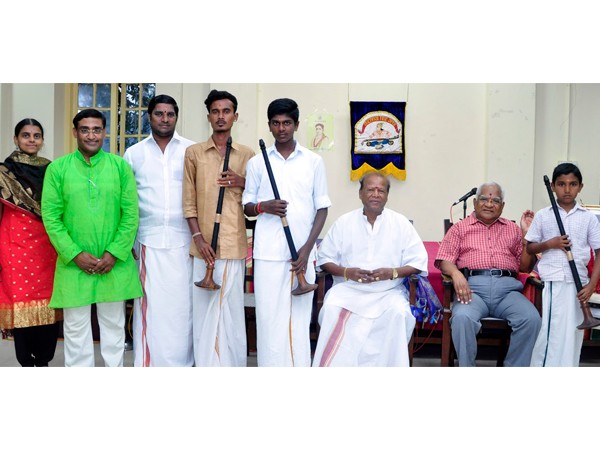
Gangadhar Pradhan Samman Award
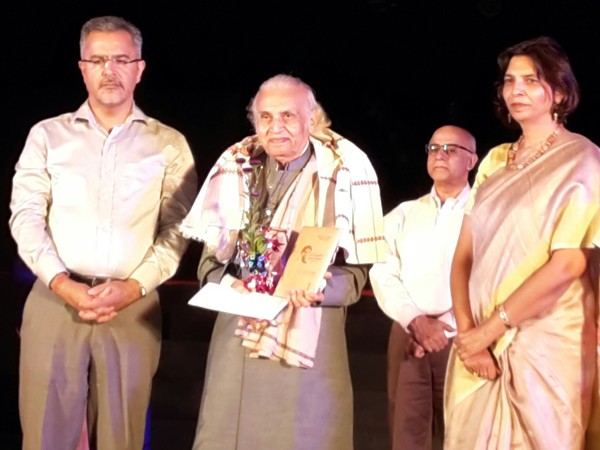
Sruti’s senior contributors Leela Venkataraman and Dr. Sunil Kothari were honoured with the Guru Gangadhar Samman by the Orissa Dance Academy in February 2017 during the Dhauli-Kalinga Mahotsav in Odisha.
Harikatha Choodamani awards

Upanyasa, Vaideeka and Harikatha Choodamani awards were confered on Dr.NY.Sivaramakrishna Ghanapatigal, Dr.M.V.Ananthapadmanabhachariar and Smt.Girija Ramaswamy respectively by YCPA & SKGS Trust in the Holy Presence of Pujyasri Jayendra Saraswathi Swamigal and Pujyasri Sankara Vijayendra Saraswathi Swamigal during the 83rd Jayanthi Celebration of Pujyasri Jayendra Saraswathi Swamigal
A double celebration for Guru Kalyani Sharma
Mumbai based eminent Carnatic musician, Sangita Kala Acharya, Kalyani Sharma, was recently felicitated by her disciples and others, to mark two milestones in her life—her 80th birthday and 60 years of musical journey. The event ‘Guru Vandanam’ organised by her disciples in Mumbai, was inaugurated by four leading ladies in Carnatic music—Bhagavathi Mani, Alamelu Mani, Radha Namboodiri from Mumbai and R. Subbalakshmi from Thiruvananthapuram. It was a mixed fare comprising felicitation by her disciples, eminent musicians and reputed sangeeta sabhas, followed by a riveting documentary on her life, and group performances by her vocal, veena and violin disciples, titled Sangeeta Samarpanam.
Click here to read more http://srutimag.blogspot.in/2017/09/a-double-celebration-for-guru-kalyani.html
Vainika Mudhra Award for R.S. Jayalakshmi at Veenotsav 2017
During the inauguration, the Vainika Mudhra Award comprising a shawl, citation, medal and purse, was presented to vidushi R.S. Jayalakshmi—musician, teacher, and musicologist—by Dr. Pappu Venugopala Rao. The award is given out of the endowment created by Chitravina N. Narasimhan in the name of his father Gottuvadyam Narayana Iyengar and Bapu Rajalakshmi Sundaram.
Varsity affiliation for Haridhos Giri School of Music
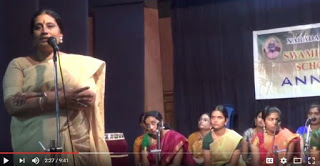
NALCO Awards
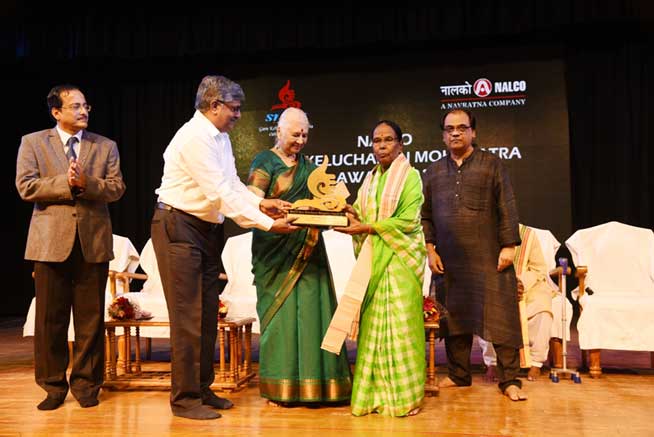
Guru Dhruba Charan Biswal and Shyamamani Devi were honoured with the NALCO Guru Kelucharan Mohapatra Award 2017 in the field of dance and music respectively. The NALCO Guru Kelucharan Mohapatra Yuva Pratibha Samman 2017 was presented to Lingaraj Pradhan (Bhubaneswar) and Namrata Mehta (Mumbai) for Odissi, Jyotsna Jagannathan (Bangalore) for Bharatanatyam and Jateen Kumar Sahoo (Mumbai) for Odissi music. The annual awards were presented by distinguished guests on 10 September 2017, the concluding day of the 23rd OMC Guru Kelu Charan Mohapatra Award Festival organised by Srjan
Prof. Indira Parthasarathy honoured
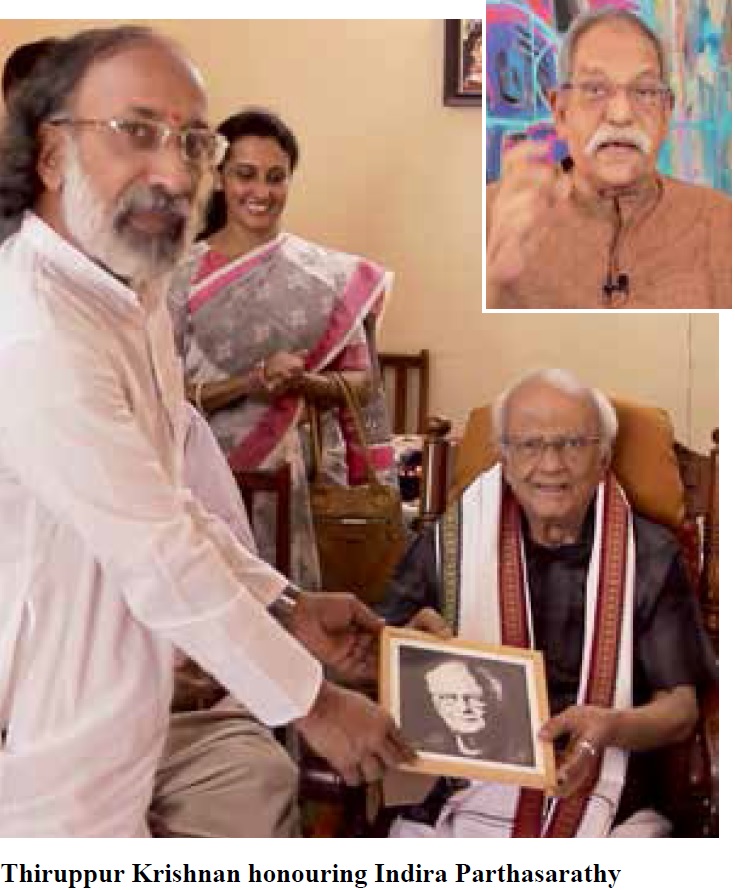
JustUs Repertory, founded by Gowri Ramnarayan, celebrated ten years in theatre, by organising Just Fest--a two-day, two-play
festival on 24 and 25 June at the Alliance Francaise in Chennai. Gowri’s two plays showcased on the occasion were her first play—Dark Horse (2005) and her latest play titled When Things Fall Apart (2017). Eminent playwright and author Prof. Indira Parthasarathy and theatre personality Na. Muthuswamy (inset) were honoured as part of the celebrations.
Book Release - Ustad Amir Khan
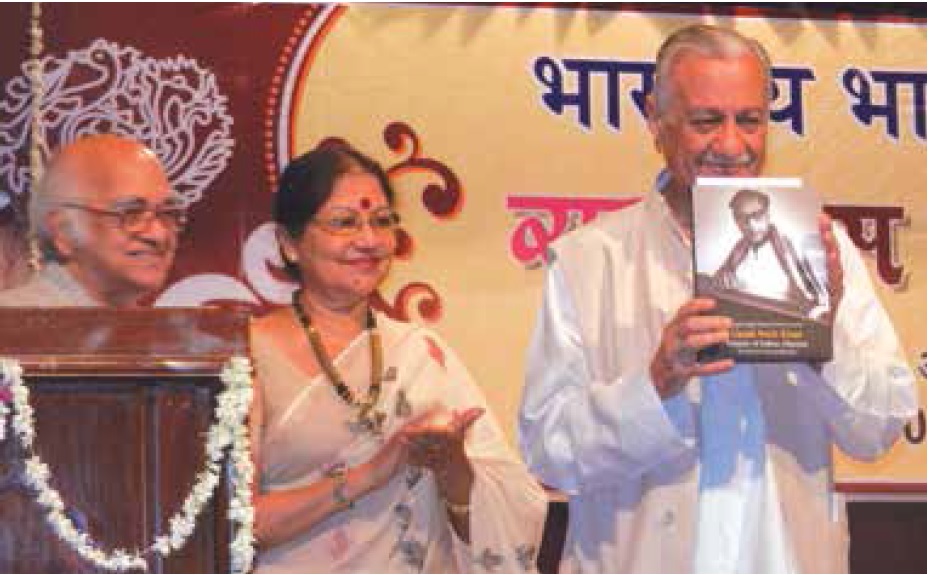
A book titled Ustad Amir Khan: Pioneer of Indore Gharana, an English translation by Meena Banerjee (scholar and critic), was released by musicologist Vijay Kichlu and noted theatre critic Samik Bandopadhyay, on 28 April at the auditorium of Bharatiya Bhasa Parishad, Kolkata. The original book in Hindi is Sangeet ke Dedeepyaman Soorya: Ustad Amir Khan by Hindustani vocalist Tejpal Singh (senior among the Singh Bandhu).
Abhai Awards

Yamini Krishnamurthy and Indira Rajan were conferred the Natya Kalanidhi awards for 2016 and 2017 by Association of Bharatanatyam Artists of India, by Chitra Visweswaran, President-ABHAI on its annual day on 1 May at the TamilNadu Eyal Isai Nataka Manram, Chennai. A number of awards were presented to artists.
Saraswathi Awards 2017
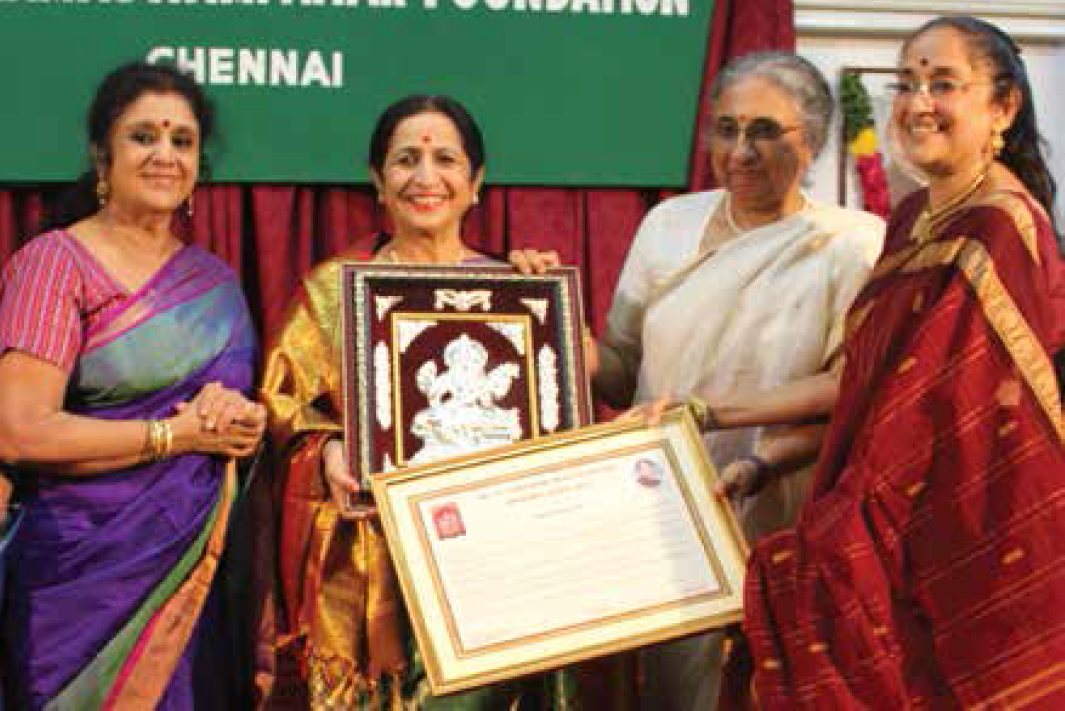
The Saraswathi Award 2017, was conferred on senior Carnatic musician Aruna Sairam on 2 September at the C.P. Ramaswami Aiyar Foundation, Chennai. The award, for lifetime service in music, was presented by Prabha Sridevan and felicitations were offered
by Chitra Visweswaran (awardee 2016). Nanditha Krishna, President of the Foundation, also spoke on the occasion. Carnatic music concerts were held on 1 and 2 September.
Kala Sadhanalaya - Award
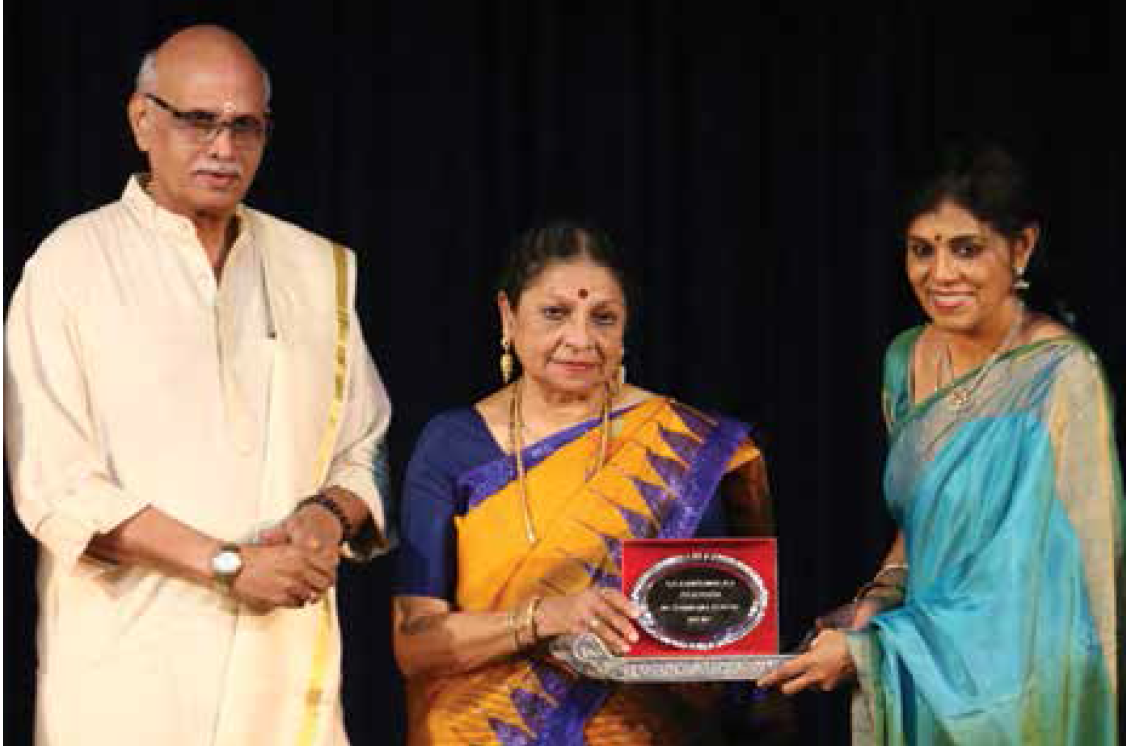
Darshana Jhaveri, veteran Manipuri dancer and guru, was honoured by chief guest Pappu Venugopala Rao during `Bhaavaarpanam’—Kala Sadhanalaya’s day-long dance festival—organised at the Bharatiya Vidya Bhavan Hall, Chennai, on
20 August 2017. The annual event is conducted by Bharatanatyam dancer Revathi Ramachandran in memory of her guru Mangudi Dorairaja Iyer.
Charubala Mohan Trust honours senior artists
Click here to read more http://srutimag.blogspot.in/2017/10/charubala-mohan-trust-honours-senior.html
Melbourne Trinity Festival
.jpg)
The Melbourne Trinity Festival is one of the largest celebrations of the Trinity outside India. Every year, around May, an enthusiastic group of Carnatic music rasikas meticulously plans the grand event which showcases an ever-increasing number of enthusiastic young performers and veteran musicians. Visiting artists from India are featured in the prime time slots which makes the festival an inclusive and holistic experience.
Click here to read more http://srutimag.blogspot.in/2017/10/the-melbourne-trinity-festival-2017.html
Sai Arts 100th Nrityotsav
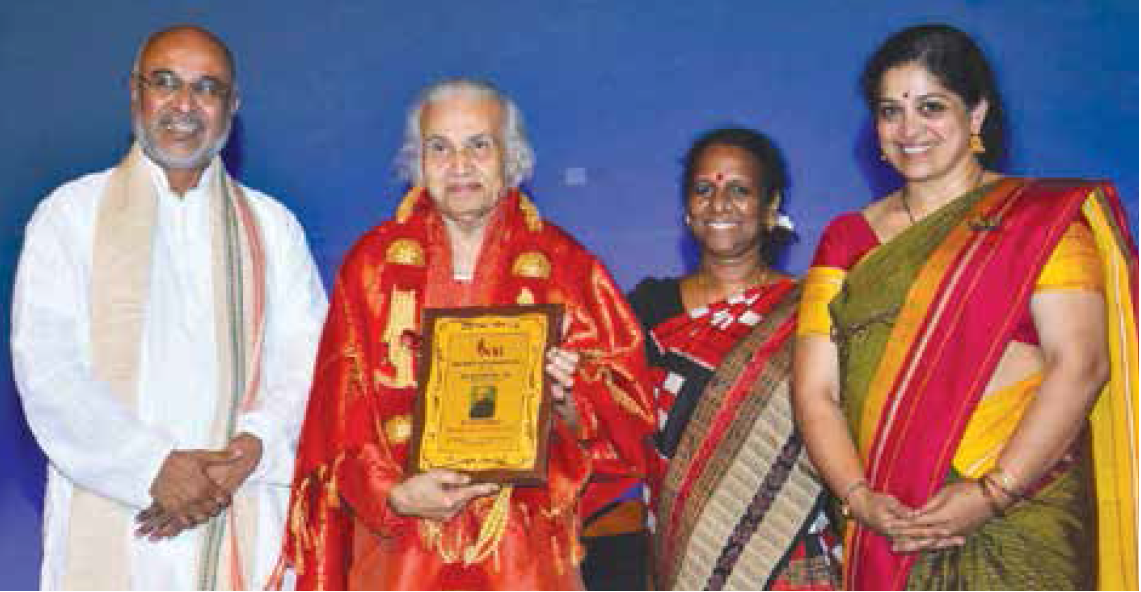
Sai Arts International celebrated the 100th edition of Sai Nrityotsav on 1 September 2017 at JSS Auditorium in Bengaluru. The festival series organised by Sai Venkatesh and wife Suparna Venkatesh was inaugurated by Helen Acharya. Veteran arts writer and
critic Sunil Kothari was felicitated on the occasion. It was followed by performances by eminent artists, an organisers’ meet and exhibition of dance books and artefacts.
Indira Sivasailam Endowment Medal
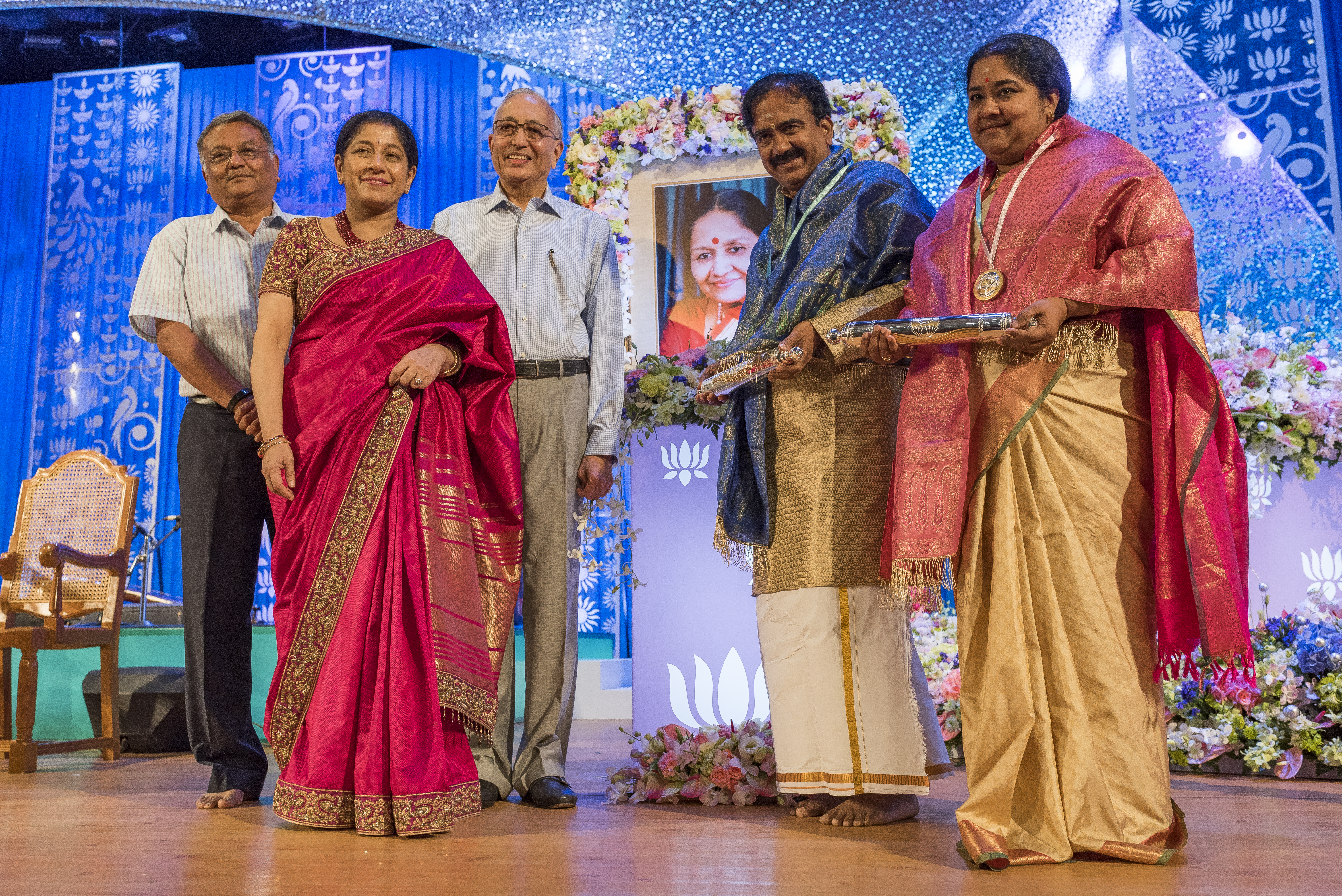
Lalgudi G.J.R. Krishnan and Lalgudi Vijayalakshmi, were conferred with the eighth Indira Sivasailam Endowment Medal and citation at the Music Academy on 22 September 2017. The award was presented by the Indira Sivasailam Endowment Foundation established by Mallika Srinivasan, Chairman and CEO, Tractors and Farm Equipment Limited, in memory of her mother Indira Sivasailam, along with the Music Academy.
Bharatiya Vidya Bhavan Margazhi Festival
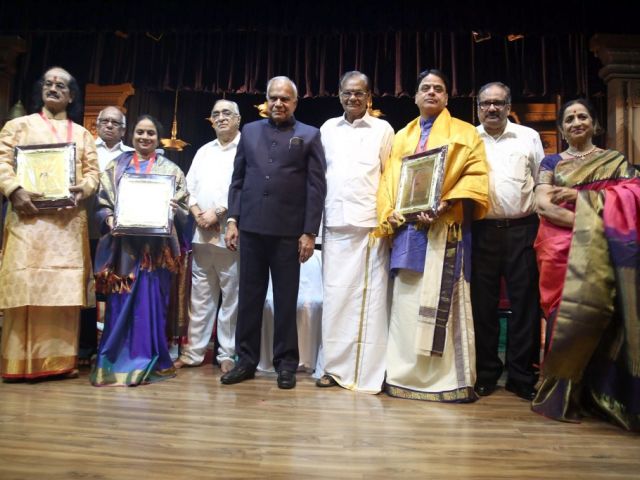
Bramha Gana Sabha Season Inauguration

Samudhra Award
Mudhra celebrated the 15th anniversary of Samudhra magazine and 250 weeks of Paalam Free Webcast on 19 November 2017 at the Infosys Hall on Bazulla Road in Chennai. Sudharani Raghupathy, veteran Bharatanatyam dancer-guru inaugurated the function and Nalli Kuppuswami Chetti, chief patron presided over the proceedings. The highlight was the conferring of the title ofGnana Samudhra on Rama Kausalya, for her outstanding contribution as a musician and musicologist, and presenting the Lifetime Achievement Award to Yoga, for his contribution as a photographer in the arts field. The much sought after Music Planner cum Directory 2018 was also released on the occasion.
click here to read more http://srutimag.blogspot.in/2017/12/fifteenth-anniversary-of-samudhra.html
Charubala Mohan Trust honours Ravikiran
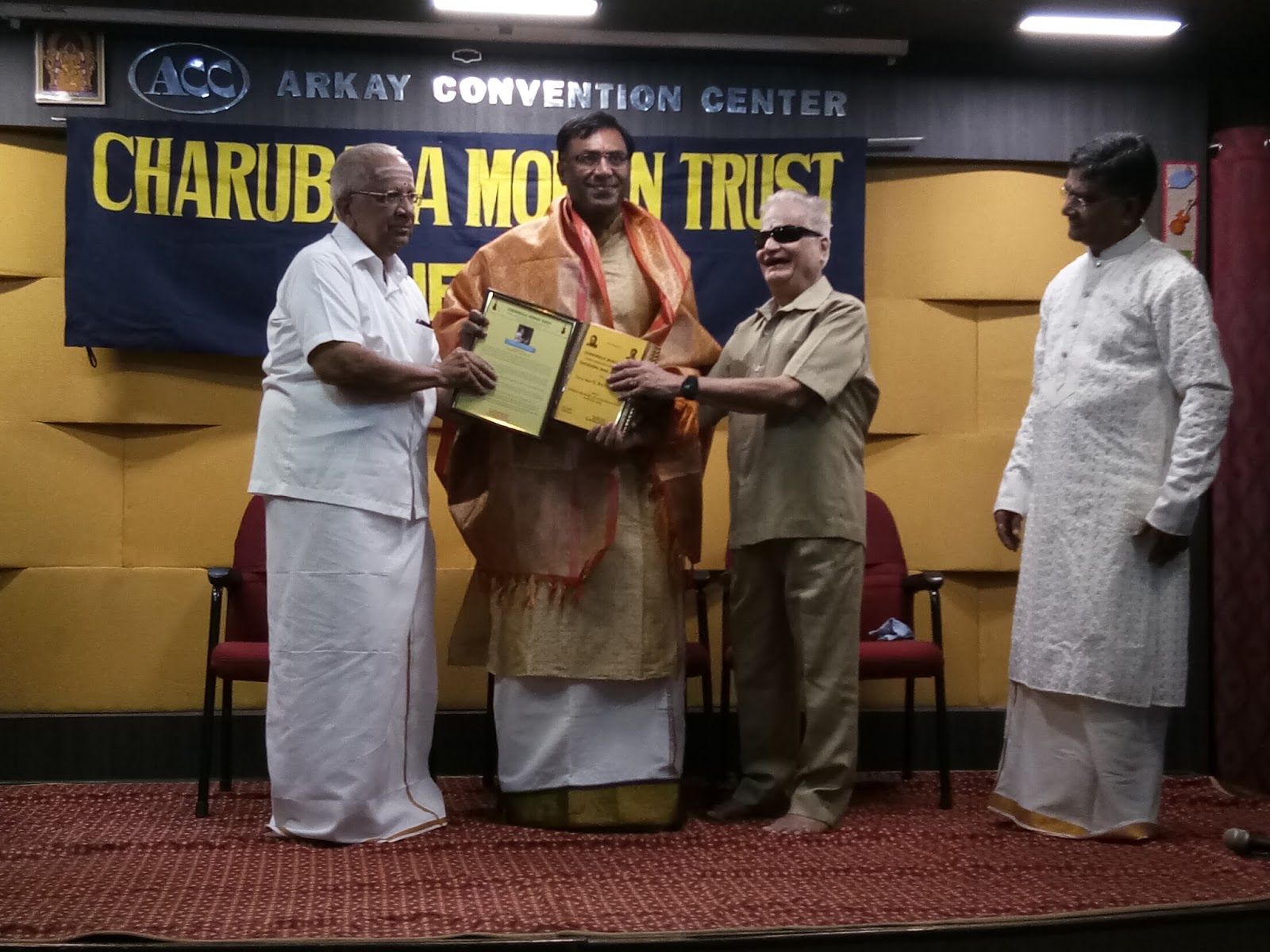
The title Chitravina Nada Jnana Mani was conferred on vidwan N. Ravikiran by violin maestro Sangita Kalanidhi M. Chandrasekharan, on behalf of Charubala Mohan Trust on 19 November 2017 in Chennai. Narasimhan, President of Asthika Samajan, Thiruvanmiyur presided over the function. It was followed by a grand chitraveena concert by Sangita Kalanidhi designate N.Ravikiran.
V. Govindasamy Naicker Centenary Celebrations
The birth centenary of violin vidwan V. Govindasamy Naicker was celebrated at P.S. School, Mylapore, Chennai on 18 November 2017. The chief guest Sangita Kalanidhi A.K.C. Natarajan recalled his long association with the violin maestro, and spoke about the gurukula system and the music of yesteryear. Srimushnam Rajarao and Sirkazhi Sivachidambaram also offered their felicitations.. A vocal concert by the talented great-granddaughters of Govindasamy Naicker--Srutipriya and Neehaara--was widely appreciated.
Tamil translation of Bengaluru Nagarathnamma’s biography released
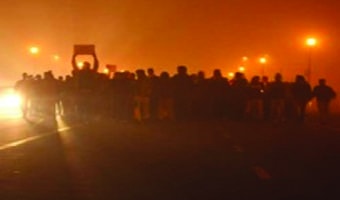
Thyagarathna—Kapilai Kadalil Sangamithal—a novel based on the life of Bengaluru Nagarathnamma, written by Kalyani Venkataraman, was released on 5 January at Tiruvaiyaru, at the Shrine to Saint Tyaga Brahmam. Bhageerathi, wife of the late Kunnakudi Vaidyanathan and member of the Nagarathnamma Committee, released the book at saint Tyagaraja’s shrine. Published by Nijaguna Foundation, Kollegal, and priced at Rs. 350, it is a translation of the Kannada book titled Kapilé HaridaLu Kadaligé written by Prof. Maleyuru Guruswamy of Mysore.
Bharatanatyam guru honoured
14 February 2018, ahead of the London Commonwealth Heads of Government meeting to be held in April.
Visakha Music Academy conferred its title Sangeeta Kala Sagara
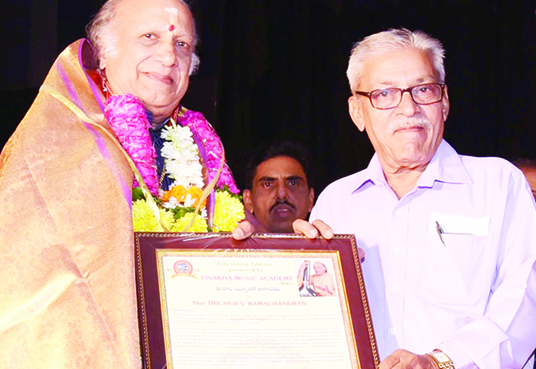
Visakha Music Academy conferred its title Sangeeta Kala Sagara on Trichur V. Ramachandran, during its 48th annual festival of music, on 26 November 2017 in Visakhapatnam.
Mudhra celebrated the 15th anniversary of Samudhra magazine
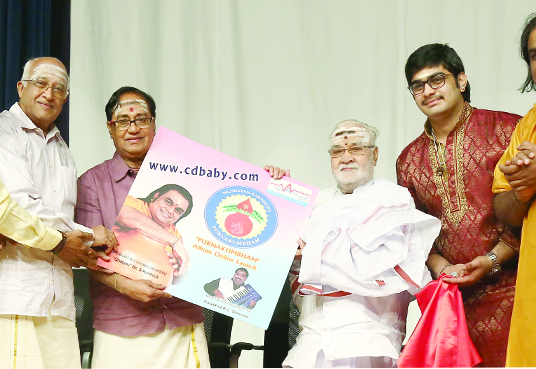
Sita Kalyanamu—a Bhagavata Mela natakam book released
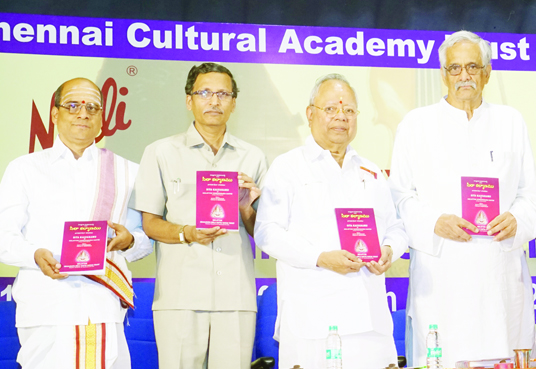
The book Sita Kalyanamu—a Bhagavata Mela natakam edited by N. Srinivasan and Dr. N.V. Deviprasad (1st and 2nd from L) was released on 22 December 2017 in Chennai. The first copy was handed over by Nalli Kuppuswami Chetti to V. Ramnarayan (4th and 5th). Madabhooshi Sampath Kumar and Revathy Ramachandran felicitated Melattur Mali (extreme R) and his team. This was followed by the staging of Rukmini Kalyanamu by members of the Melattur Bhagavata Mela Natya Vidya Sangam.
Purnakumbham Album online launch

Purnakumbham, a musical album comprising 30 original compositions of ‘Ghatam’ Dr. S. Karthick, was released on 23 November 2017 at the R.R. Sabha Hall in Chennai. It marked Ghatam Karthick’s completion of 30 years as a musician. His guru, vidwan T.H. Vinayakram, launched the album online and also released three CDs titled Kumbham, Kalasam and Kataksham. Karthick’s teachers Prof. Va.Ve.Su, Dr. S. Ramaratnam and vidwan T.H. Subashchandran, blessed him and also received the logo as a mark of the online launch. The release function was followed by Sudha Raja’s Sargam Choir singing a few songs from the album, and Bharatanatyam dancers Shweta Prachande and Sudharma Vaithiyanathan dancing to a few songs from Purnakumbham.
Tamil Isai Perarignar on vidwan T.M. Krishna.
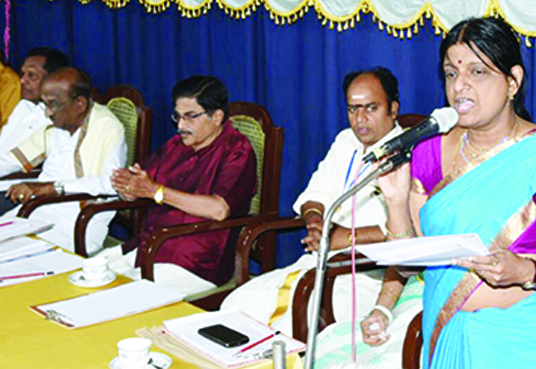
The Tamil Isai Sangam has been doing yeoman service in pann research from 1949. This season the pann research conference took place on 24 December 2017, and the panns Narayani and Velavali were discussed. Dr. M.A. Bhageerathi presented a paper on pann Velavali which is the present day raga Gaurimanohari. Mylai Sadgurunada Oduvar presented the kattalais for the pann Nattapadai. Also seen in the picture are Dr. Sirkazhi Sivachidambaram, Dr. Thangarasu, Justice P. R. Gokulakrishnan and T.K.S. Kalaivanan. The Tamil Isai Sangam conferred the title Tamil Isai Perarignar on vidwan T.M. Krishna.
Bharatanatyam dancer and teacher Indira Kadambi receiving award

Bharatanatyam dancer and teacher Indira Kadambi receiving the Vidhya Tapasvi award instituted by Tapas Cultural Foundation, Chennai, from Dr. R. Nagaswamy and N.S. Jayalakshmi on 18 February 2018.
Carnatic musician T.V. Ramprasadh receiving the award
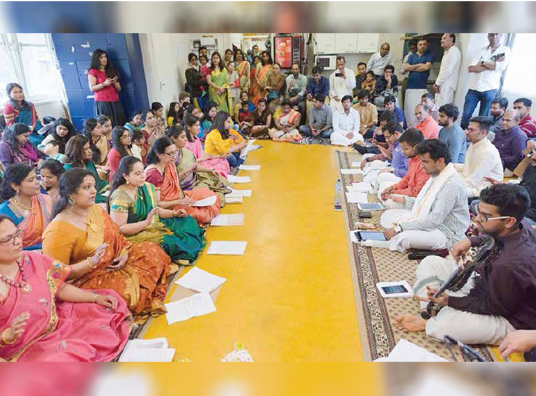
Carnatic musician T.V. Ramprasadh receiving the Dasa Kala Rathna award instituted by Purandhara Daasar Trust, Chennai, from the Bombay Sisters on 10 March 2018.
Lecdem by T.R. Govindarajan
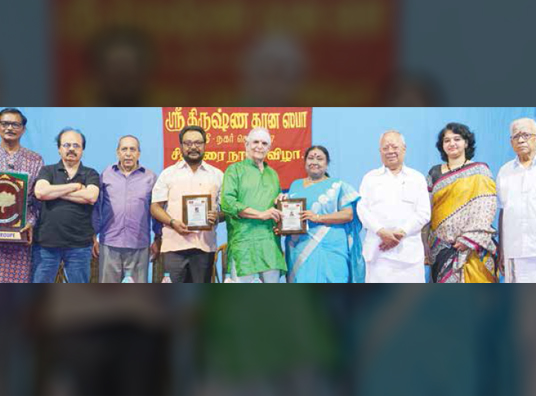
T.R. Govindarajan presenting the Parlandu Award
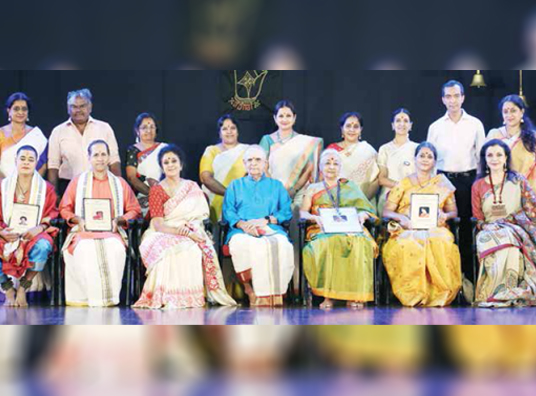
Ranjani - Gayatri Honoured
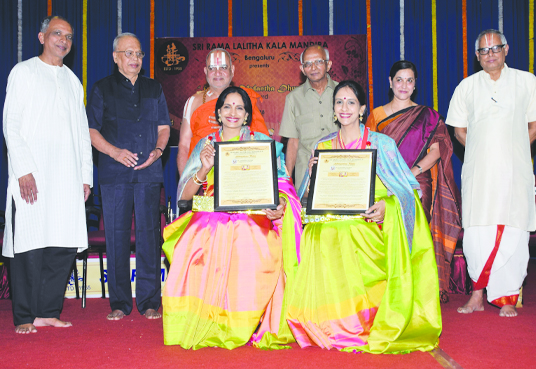
Revathi Ramachandran is the new Director of Kalakshetra

Revathi Ramachandran has officially
taken charge as Director of Kalakshetra on 20 April 2018. It is a welcome move
as the post was vacant for almost eight months.
Revathi Ramachandran, Bharatanatyam
dancer, choreographer and teacher, is a direct disciple of Guru
Mangudi Durairaja Iyer.
An A Grade artist of Doordarshan,
Revathi has performed in prestigious organizations in Chennai and different
parts of India. She has travelled widely to many countries including the United
States, France, Germany, Australia, the United Kingdom, and Italy for group
presentations and workshops.
As recipient of a fellowship
from the Ministry of Human Resource Development, Revathi has done
research on the traditional art of Bhagavata Mela. She has assisted famous
scholars like T.S. Parthasarathy, Dr. Arudra and Dr. R. Nagaswamy in their
lectures, by demonstrating Suddha Nrittam and Tiru Tala Jati. Revathi has
coordinated the production of a CD-ROM titled ‘Bharathanatyam’ apart from
choreographing and directing teleserials like ‘Deiveega Tirumanangal’,
‘Kodhai Paadiya Paavai’ and ‘Gnaana Parambarai’. She had the opportunity of
performing in the Hindi teleserial 'Noopur' presented by dancer-actor
Hemamalini.
Over the years, Revathi has been
exploring the richness of classical dance guided by various gurus, including
Dr. Padma Subrahmanyam. Her understanding of the art has been further
enriched by her training in nattuvangam with Guru Bhagavatulu Seetarama Sarma,
veena from Kalpagam Swaminathan and Kuchipudi from Guru Vempati Chinna
Satyam.
She is the recipient of several
awards including the Nadana Maamani, Yuva Kala Bharathi, Isai Kalai Chelvar,
Natya Kala Sikhamani and the Arsha Kala Bhushanam Award.
Every year Revathi diligently pays homage to her Guru Mangudi Dorairaja Iyer by organising a festival in his memory.
Pudukottai Krishnamurthy is no more

"A Great loss to the Music Fraternity,"
said veena vidwan Ananthanarayanan in a Facebook post today. He added:Maha vidwan veena maestro Pudukkottai R.Krishnamurthy passed away today.
My sashtanga namaskarams.
"Please don't miss this great video "
https://www.youtube.com/watch?v=Q3jQKBOnDy8&sns=em
Another veena artiste Ramnath Iyer said:
"Very sad news. A great vainika who combined tradition and modernity in his playing. He had developed special fingering techniques that made his concert very engaging and exciting for the audience. May his soul reach the Almighty."
Prof S. Rajeswari was honoured by Sahana Fine Arts
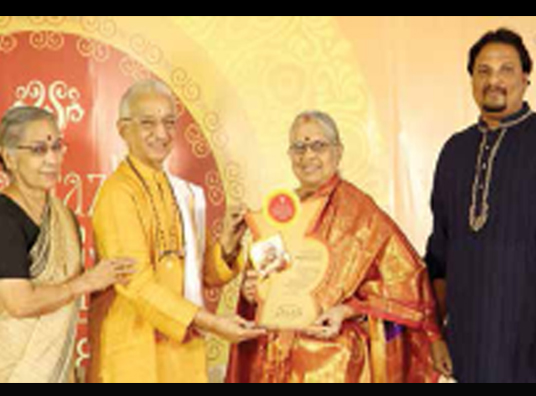
Prof
S. Rajeswari, retired Principal of the Tamil Nadu Government Music College, was
honoured by Sahana Fine Arts in Mogappair. The title of Isai Chudaroli was conferred
on the Carnatic musician by Natya Kalanidhis Shanta and V.P. Dhananjayan on 7
January 2018. The Dhananjayans paid rich tribute to the awardee and described
her as an all-rounder—a concert singer, excellent teacher, musicologist, and
composer who has the special qualification of singing with aplomb and
conducting a Bharatanatyam performance. They also recalled how connoisseurs would
throng to watch Kamala—the doyen of Bharatanatyam—and listen to S. Rajeswari ‘s
excellent vocal accompaniment. A good crowd attended the event and the Carnatic
vocal concert by S. Rajeswari who was accompanied by Usha Rajagopalan (violin)
and Tanjavur Subramaniam (mridangam). This is the ninth year that Sahana Fine
Arts is conducting a music and dance festival. Next year being the tenth, the
convenor, violinist Arun Karthik, announced that a ten-day art festival would
be held to mark the occasion, which was welcomed with applause by the audience.
Thyagarathna—Kapilai Kadalil Sangamithal—a novel
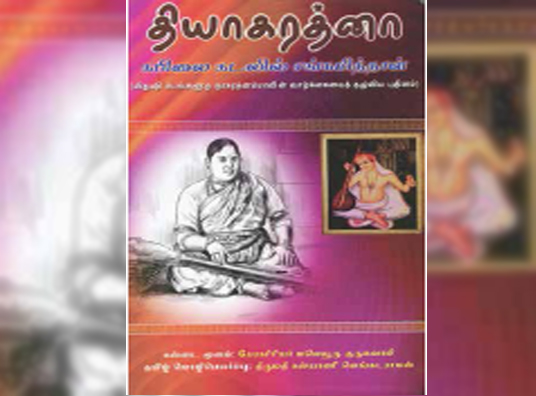
Thyagarathna—Kapilai Kadalil
Sangamithal—a novel based on the life of Bengaluru
Nagarathnamma, written by Kalyani Venkataraman, was released on 5 January at
Tiruvaiyaru, at saint Tyagaraja’s shrine. Bhageerathi, wife of the late
Kunnakudi Vaidyanathan and member of the Nagarathnamma Committee, released the
book. Published by Nijaguna Foundation, Kollegal, and priced at Rs. 350, it is
a translation in Tamil of the Kannada book titled Kapilé HaridaLu Kadaligé written by Prof. Maleyuru Guruswamy of Mysore.
Shri Purandaradaasar Trust honoured Carnatic musicians
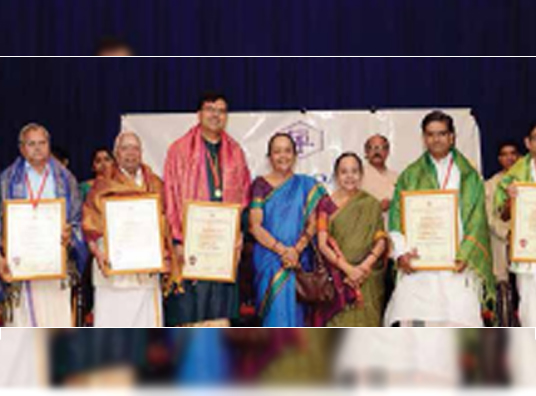
Shri Purandaradaasar Trust honoured Carnatic musicians T.V.
Ramprasadh, Carva C.A. Rajasekar, and R. Ramesh with the Dasa Kala Rathna
awards, organiser S. Rajaraman with the A.R. Kannan Memorial award, mridangist
Sengottai A. Rajamani with the R.N. Ganesan Memorial award, vocalist Amritha
Murali with the G.N.B. Memorial award and young musicians R.D. Adharsh and M.
Anandhulal, on 10 March in Chennai. The Bombay Sisters presented the awards and
presided over the sixth anniversary celebrations of the Samajam.
Indira Kadambi received the Vidhya Tapasvi award
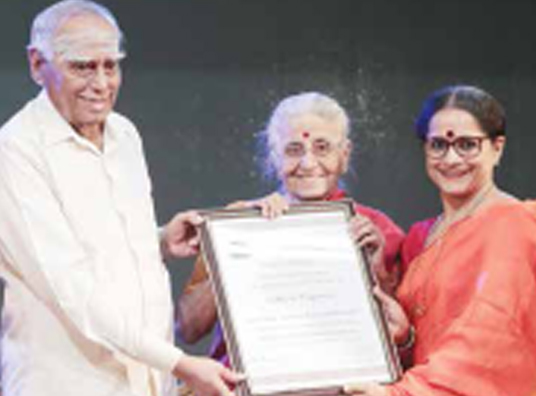
Bharatanatyam dancer and teacher Indira Kadambi received the
Vidhya Tapasvi award instituted by Tapas Cultural Foundation, Chennai, from Dr.
R. Nagaswamy and N.S. Jayalakshmi on 18 February 2018.
22nd edition of the Sangit Kala Kendra Awards function
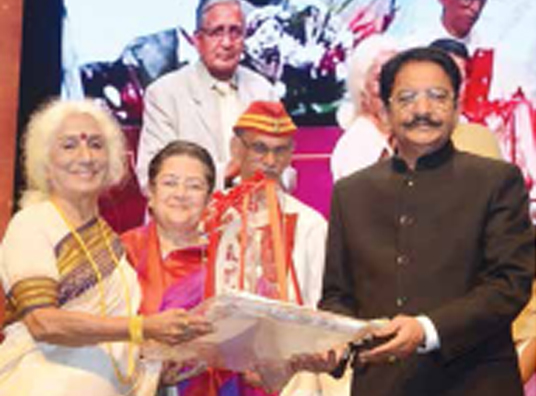
At the 22nd edition of the Sangit Kala Kendra Awards function, C. Vidyasagar Rao, Governor of Maharashtra, presented the Aditya Vikram Birla Kalashikhar Puraskar 2017 to Prabha Atre, veteran Hindustani vocalist. The Aditya Vikram Birla Kalakiran Puraskars were presented to Anol Chatterjee and Sawani Shende Sataye.
Lalitharam's brilliant presentation on GNB's music
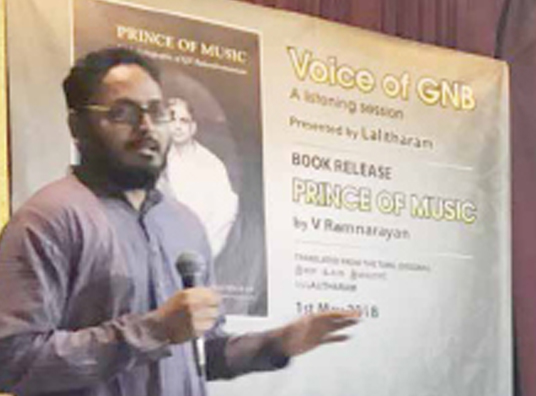
Lalitharam, author and Carnatic music conservationist, made a brilliant presentation (featuring a listening session) on G.N. Balasubramaniam’s music on 1 May 2018—GNB’s death anniversary— on the occasion of the release of Prince of Music, by V. Ramnarayan, an English translation of Lalitharam’s GNB biography Isai Ulaga Ilavarasar. The hall was packed at Raga Sudha, Mylapore, the venue of the event. G.N. Balakrishnan (GNB’s brother), received the first copy of the book. Another close relative, T.V. Gopalakrishnan, GNB’s disciple Sangita Kalanidhi Trichur V. Ramachandran and Mathangi, granddaughter of another disciple, the late T.R. Balasubramaniam, also received copies.
T.Balasaraswati's 100th birthday

As part of the celebration of T. Balasaraswati’s 100th birthday, the Dr. V. Raghavan Centre for Performing Arts (Nandini Ramani, Managing Trustee), honoured veteran dance critic and scholar, V.A.K. Ranga Rao on 13 May at Ragasudha Hall, Mylapore in Chennai. Cleveland V.V. Sundaram, organiser and arts administrator, presided over the function. Revathi Ramachandran (Director - Kalakshetra Foundation), and Roja Kannan (President ABHAI), felicitated the awardee. It was followed by a special concert of padams and javalis rendered by S. Sowmya.
Carnatic music tradition of Sri Lanka
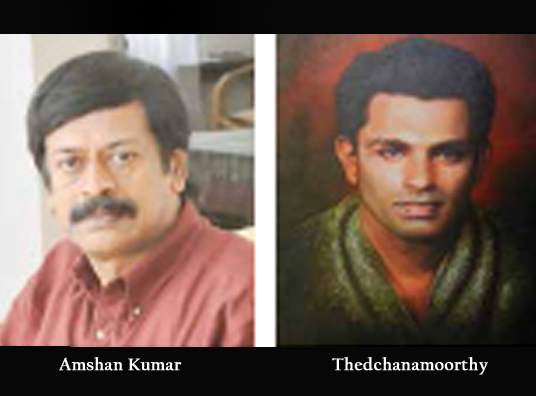
Renowned documentary film maker Amshan Kumar gave a talk entitled ‘Carnatic Music Tradition of Sri Lanka’ followed by the screening of his documentary on tavil vidwan Yazhpanam Thedchanamoorthy on 5 May 2018 at Arkay Convention Centre under the auspices of Tamil Heritage Trust. The Trust offers monthly programmes celebrating the Tamil heritage besides conducting regular tours and site visits of historical and archaelogical interest.
Ganesa Natyalaya honours the Dhananjayans
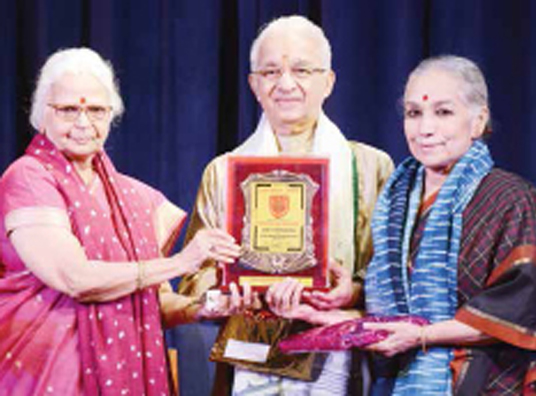
Natyacharyas Shanta and V.P. Dhananjayan were honoured with the title and award Shreshta Kalaa Pracharak by Saroja Vaidyanathan’s Ganesha Natyalaya, New Delhi on 9 April 2018. The award function was held in the Delhi Tamizh Sangam auditorium, R.K. Puram, and the award was presented by Governor of Goa Mridula Sinha.
Guru C.V. Chandrasekhar receives Utsav Nritya Ratna title
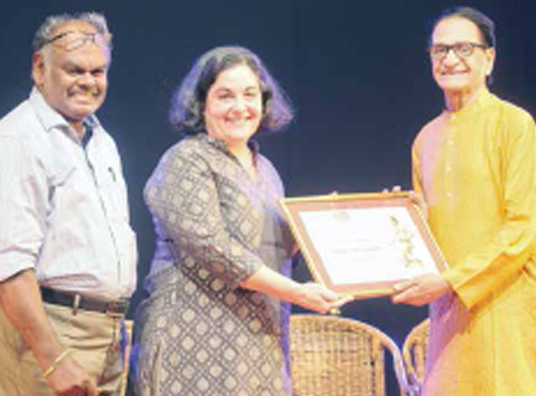
The
title of Utsav Nritya Ratna was conferred on Bharatanatyam guru Prof. C.V.
Chandrasekhar by chief guest Deborah David, Vice Consul General, U.S.
Consulate, Chennai, on the occasion of the International Dance Day celebrations
organised by Utsav on 29 April 2018 organised at the Nalli Gana Vihar of Sri
Krishna Gana Sabha. Utsav Music was founded in 1999 by Churchill Pandian to
take classical arts to the people and to draw in the younger generation. The
award function was followed by an interesting presentation of Bharatanatyam
(Priyadarsini Govind), Kuchipudi (Bhavana Reddy), and Kathak (Sanjukta Sinha).
Tyagaraja Aradhana in Paris

The Paris Tyagaraja Aradhana was organised by Carnatic Conservatory of Paris (founded by Bhavana Pradyumna)
at the S.R.C.M Centre on 20 May 2018. The aradhana began with the lighting of the lamp and singing of Pillari
Geetegalu and the kriti Guruleka yatuvanti. The group rendition of the Pancharatna kritis was led by Padma Malini
Raghunandan, Bhavana Pradyumna and Srividya Badri Narayan with Venkata Krishnan on the mridangam. The
musical structure and meaning of the kritis were explained in French. CCP students also sang kritis of Tyagaraja and
Purandaradasa. As the event also focussed on ‘Guru-sishya’, the Carnatic Conservatory of Paris honoured gurus
Malavika and Padma Malini Raghunandan.
Tyagaraja Aradhana in The Netherlands

Tyagaraja Aradhana was conducted at Sri Arunachaleswara Temple in Beverwijk, an hour’s drive from Amsterdam.
The three-hour programme had over 40 participants and around 400 spectators. Singers, instrumentalists and the
audience had a unique experience on the occasion. The Madras Chorus that organised the event, is an association of
musicians, singers and music lovers of Delft, educational hub of The Netherlands.
SKGS Chithirai Nataka Vizha Awards

At the 26th Chithirai Nataka Vizha organised by Sri Krishna Gana Sabha in Chennai, chief guest mridanga
maestro Umayalpuram K. Sivaraman conferred the title ‘Nataka Choodamani’ on S.B. Khanthan, and presented
the ‘Poornam New Theatres’ Rolling Trophy for the best drama troupe to Vivek Shankar’s Prayatna and the ‘Iyakunar
Sigaram K.Balachander Award for Excellence in Theatre’ to S.N. Parvathi. Also in the picture are Vivek Shankar, Crazy
Mohan, Kathadi Ramamurthy, Nalli Kuppuswami Chetti (President, SKGS, Saashwathi Prabhu and R. Venkateswaran,
Joint Secretary, SKGS).
ABHAI Awards 2018
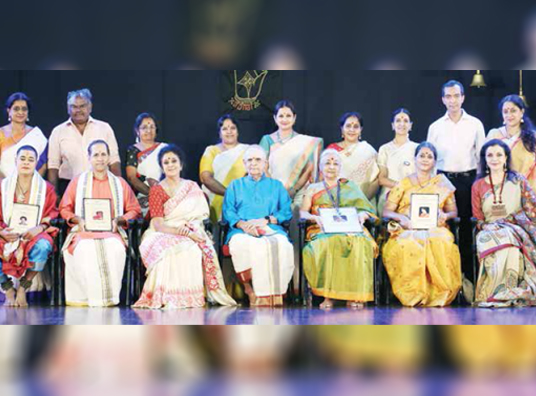
On the occasion of its 30th anniversary, Association of Bharatanatyam Artistes of India (ABHAI), honoured
several senior artists on 1 May at Vani Mahal in Chennai. A group dance choreographed by Binesh Mahadevan
was presented by 30 dancers to signify ABHAI’s 30th anniversary.
The prestigious Natya Kalanidhi awards were presented to veteran dance gurus Sudharani Raghupathy and Padma
Subrahmanyam (in absentia). Senior Bharatanatyam dancers and teachers Jayanthi Subramaniam and J. Suryanarayana
Murthy received the Nritya Perunjothi and Narthaka Nipuna awards respectively. The Gandharva Nipuna award was
presented to veena vidwan Mudicondan S.N. Ramesh. The awards were given away by chief guest Sangita Kalanidhi
Umayalpuram K. Sivaraman.
The award ceremony was followed by a group presentation in Bharatanatyam of a varnam learnt during the summer
workshop conducted by senior dancer-guru Sathyanarayana Raju in 2017.
World Music Day in the Twin Cities
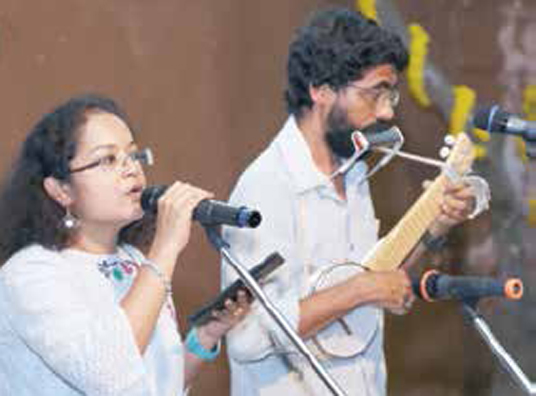
Trinity and Nandhikeshwara festivals in Melbourne

Devoted to her father’s legacy
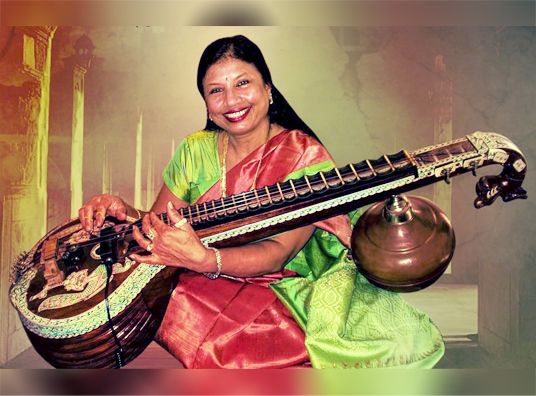
Geetha Bennett (1950-2018)
Felicitations to Mannargudi Easwaran
Disciples,
family members and admirers of mridanga vidwan Mannargudi Easwaran gathered in
large numbers on 11 August 2018 at the Narada Gana Sabha
auditorium, Chennai to celebrate his sixty years of service to music. The congregation underscored the affection and regard his
peers, disciples and family members have for this vidwan who has embellished the concerts of many senior and
junior musicians. The evening commenced with the screening of a documentary on Easwaran, curated by his senior
disciple Mudhra Bhaskar.
The documentary
had many clippings from various concerts played over decades and included
comments from his family members. The videos of the mridangam
classes including senior and junior disciples revealed Easwaran’s dedication, sincerity and discipline in his teaching.
Nalli Kuppuswami
Chetti, Cleveland V.V. Sundaram, Guruvayur Dorai, Karaikudi Mani, Nagai
Muralidharan, Sanjay Subrahmanyan and Rajasubramaniam (elder
brother of Easwaran) felicitated Easwaran. Nalli released the brochure on Mannargudi Easwaran and presented the first copy to his guru
mridanga vidwan Guruvayur Dorai.
Mannargudi
Easwaran thanked all the dignitaries, music vidwans, his peers, family members,
music students and rasikas for making the
event a memorable one. Neharika Umasankar sang the invocation, and Radha
Bhaskar, senior musician and writer, compered the proceedings in a
professional manner.
The function was
followed by the concert of Sanjay Subrahmanyan who was accompanied by S.
Varadarajan (violin), Neyveli Venkatesh (mridangam) and S.
Venkatramanan (khanjira). Although the concert started late after the
felicitation function, it was wholesome music for the
rasikas.
C. RAMAKRISHNAN
Lalit Arpan Festival of Dance and Music
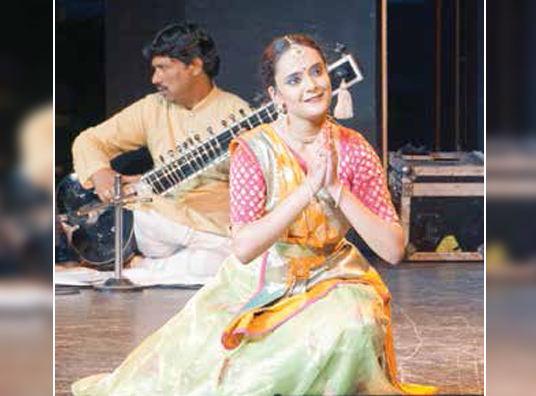
The 17th edition of the Lalit
Arpan Festival conducted in Delhi on 27 and 28 September 2018 was a rasika’s
delight. It was well organized under the guidance of guru Shovana Narayan,
Jyotsna Suri and Harish Narula. The festival commenced with the conferring of
the Lalit Arpan Samman on stalwarts like Guru Birju Maharaj (Lifetime Samman),
Iqbal Ahmed Khan and Alka Raghuvanshi.
The
festival started on a high note with the energetic Kathak performance of young Mrinalini,
a student of guru Shovana Narayan since the age of six. Mrinalini’s pleasant disposition
and confidence as a dancer reflected the hours of practice that led to her
commendable presentation. In between the performance, Mrinalini mentioned that
she had grown up watching all the previous editions of the Lalit Arpan festival,
and was ecstatic to be
finally
performing in it.
Next
was a Kuchipudi performance by Shallu Jindal, a disciple of Raja and Radha
Reddy. Through her graceful movements, professional footwork and abhinaya,
Shallu depicted famous stories from Lord Krishna’s childhood. Her intricate
movements and balance on the brass plate, which seemed effortless, won her
several rounds of applause from the audience. She also danced to a Meera bhajan
(Sanson ki mala pe simruun main pee ka naam), enunciating the bhakti and rakti between two souls.
On
day two of the festival, audiences were treated to Ragini Madan’s riveting
Kathak performance. Another student of Shovana Narayan, Ragini’s style is a
blend of the Lucknow and Jaipur gharanas. Ragini, who has been performing in
the UK for more than a decade, performed in India after a gap of 12 years. Her
passion for and excellence in Kathak were evident in her sweeping movements and
dizzying circles. Ragini also went on to enact the sacrifice of Yasodhara,
Gautama Buddha’s wife, penned by Maithili Sharan Gupt. She powerfully emoted
Yasodhara’s plight and distress through her darting eye movements and beautiful
expressions.
The
second performance of the day was by Kristina Dolonina of Lithuania, also a
student of Shovana Narayan, who danced at the Lalit Arpan Festival in 2007. The
relentless speed of her turns and spins was impressive, and it was heartening
to see a foreigner performing an Indian dance form so exquisitely. With a Masters
in Hindi from the Jawaharlal Nehru University, she addressed the audience in flawless
Hindi. Her abhinaya
piece
was an interweaving of two poems by two women in two countries—India’s Mahadevi
Varma and a Lithuanian poet—similar in their feelings about pain, suffering and
divinity. Kristina is actively involved in promoting Kathak in her country.
A
fitting finale of the two-day festival was a soulful music soiree by
sitar-sarod brothers Lakshay and Ayush Mohan, who said that it was special for
them to be performing in Delhi, their own city. Playing an interactive jugalbandi
in raga Durga with harmonious understanding, their chemistry was perfect.
Towards the end of the show, their strings strummed at lightning speed,
reaching a crescendo. It enthralled the audience which broke out in resounding
applause.
Overall,
the Lalit Arpan Festival set high standards in both dance and music.
NEHA KIRPAL
(Freelance writer)
Special Lifetime Achievement award

Ghatam maestro T.H. ‘Vikku’ Vinayakram was presented the Special Lifetime Achievement award by the Music Academy, Chennai on 10 October 2018. The evening opened with a special percussion performance, Guru Laya Samarpanam, by Vinayakram with his prime disciples. Chief guest Pandit Hariprasad Chaurasia and special guest of honour, Sangita Kalanidhi Prof. T.N. Krishnan presented the citation and medal to Vikku Vinayakram. He is the third artist to receive the special lifetime achievement award from the Music Academy after dancer Kamala Narayan and Lalgudi G. Jayaraman.
Visakha Music Academy Award
Visakha Music Academy, Visakhapatnam presented the Mangalampalli Balamuralikrishna Endowment Award to Mandapaka Sarada on 7 July 2018. It was followed by her vocal concert featuring compositions of 20th century vaggeyakaras. The Academy presented the M.S. Subbulakshmi Endowment Award to vocalist Amritha Murali on 22 September 2018. The felicitation function was followed by Amritha’s vocal recital. S.V. Rangarajan (president), M.S. Srinivas (secretary), and other members were also present.
KGS Confers Choodamani Awards
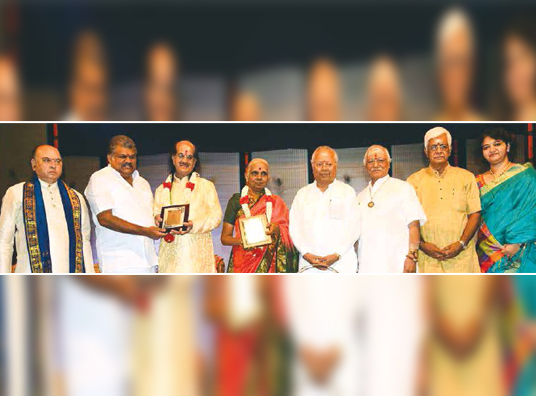
The Sangeeta Choodamani and Acharya Choodamani titles were conferred on Kadri Gopalnath (saxophone) and Suguna Varadachari (musician-guru) respectively, by G.K. Vasan, president of the Tamil Manila Congress, during the inaugural function of the 63rd Gokulashtami Sangeetha Utsavam on 1 September at Sri Krishna Gana Sabha, Chennai. Sangita Kalanidhi T.V. Gopalakrishnan and Prof. Mysore V. Subramanya felicitated the awardees. Office bearers of YCPA Sri Krishna Gana Sabha Trust were also present.
Journal on Laya in Carnatic Music
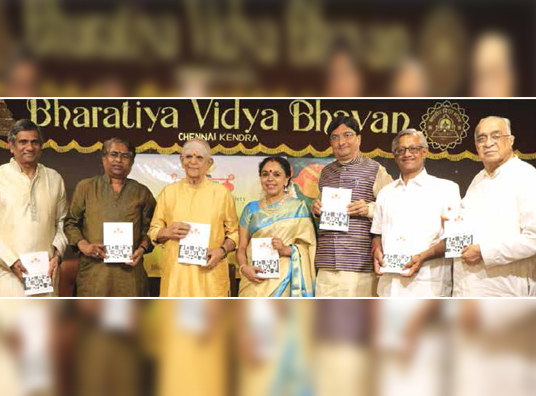
Indian Musicological Society, in association with the Music Forum, released a special journal Laya in Carnatic Music, on 21 October 2018 in Chennai. The first copy of the journal was presented by Sangita Kalanidhi Umayalpuram K. Sivaraman to Sangita Kalanidhi Sudha Ragunathan. Dr S. Sunder, Convener, Music Forum, Chennai Chapter; Ganeshkumar, Chairman, Music Forum; Snehal Muzoomdar, president of the Indian Musicological Society; and K.N. Ramaswamy, Director, Bharatiya Vidya Bhavan; offered their felicitations. Articles on laya, written by eleven eminent authors, have been compiled and edited by senior mridangist Mannarkoil J. Balaji (2nd from R).
Duddu Radhika's Releases Audio Album
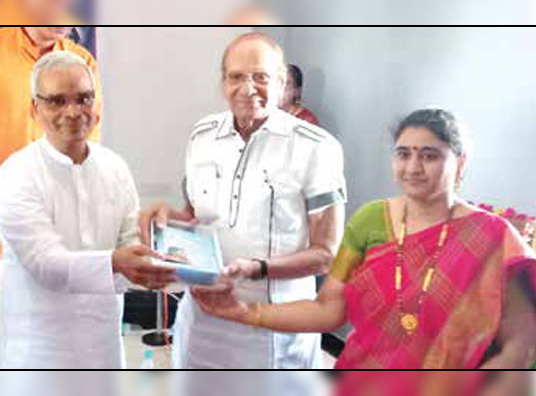
Sri Kartikeya Gana Sabha organised a Carnatic music jam session titled Nada Yogam on the occasion of World Music Day on 21 June 2018 in Hyderabad. The two-hour session was anchored by musician D. Raghavachari (elder of the Hyderabad Brothers). He and Gudipoodi Srihari, senior journalist, released the thematic audio album of musician Duddu Radhika, titled Kovur Pancharatnas of Sadguru Tyagaraja. Radhika is also the founderpresident and managing trustee of Sri Kartikeya Gana Sabha.
Ghantasala Puraskar for Legends
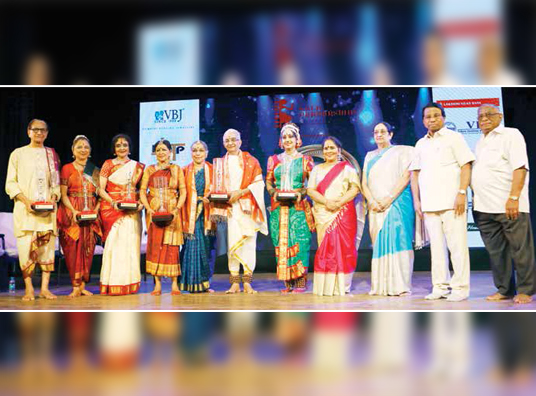
Veteran dancers and gurus—C.V. Chandrasekhar, Leela Samson, Vyjayantimala Bali, Saroja Vaidyanathan, Shanta and V.P. Dhananjayan, and Sobha Naidu—were honoured with the Kala Pradashini - Ghantasala Puraskar on the occasion of the 96th birth anniversary of Gana Gandharva Ghantasala, on 5 October at the Narada Gana Sabha hall in Chennai. The dance legends paid tribute to the musical genius of Ghantasala by performing to some of his songs. The awards were presented by the chief guests V.L. Indira Dutt, Managing Director, The KCP Limited, and G. Viswanathan, founder and Chancellor , VIT University, Vellore. The programme was organised by Parvathi and her husband Ravi Ghantasala, who run Kala Pradarshini.
Mega show by Saradhi
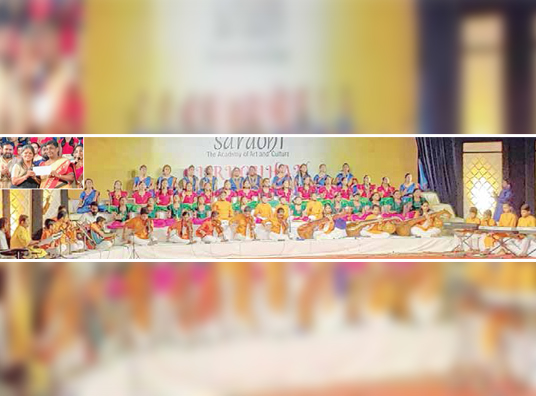
Music students of Saradhi Academy of Art and Culture presented 36 nottuswarams of Muthuswami Dikshitar in a programme titled Guruguham, on 7 September at the Sathguru Gnanananda Hall in Chennai. It was a mega show involving around 60 students of music (vocal, veena, violin, flute, keyboard and guitar). On that day, Saradhi also handed over its contribution to the Kerala Chief Minister’s flood relief fund, to the special officer Anu P. Chako.
Sumitra Charat Ram award
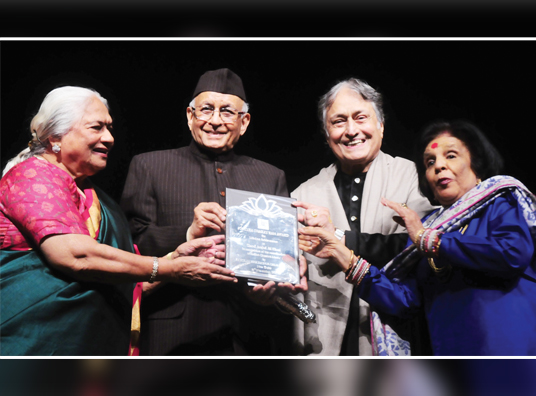
Sri Shanmukhananda M.S. Subbulakshmi Sangeetha Pracharya award
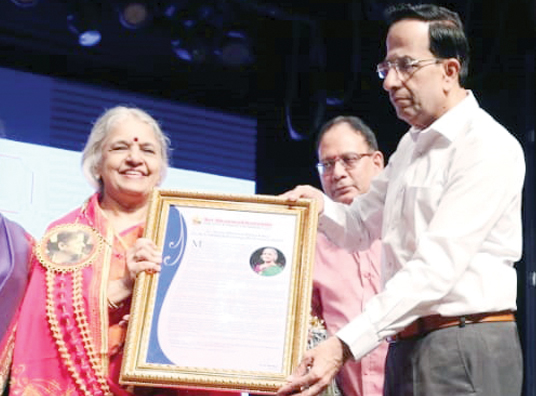
MDR Book release

Prabasi Bharatiya Samman in dual domains
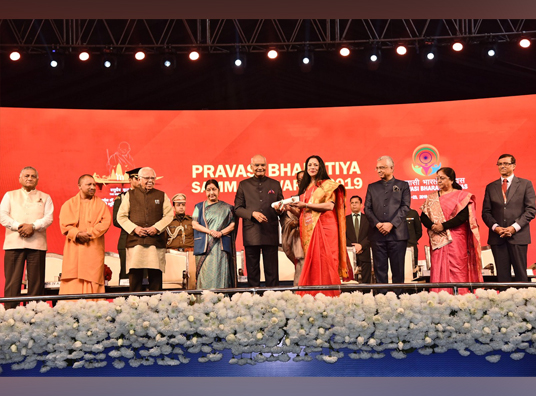
French national of Indian origin, Malini Ranganathan, an
internationally acclaimed Kathak exponent was conferred the prestigious Prabasi
Bharatiya Samman Award by the President of India, Ram Nath Kovind on
23 Jan 2019 in Varanasi, for her extraordinary contribution in academics and
arts.
From studying textile designing in
Mumbai to donning the cap of a professor of humanities and educational science
in France, Malini has kept her passion of dance and music steady and vibrant.
Trained both in the Lucknow and Jaipur gharana in kathak from Damayanti Joshi
and Roshan Kumari, she learnt Odissi from Mahadev Raut and imbibed the nuances
of nattuvangam from her mother.
Fluent in English, Hindi, Urdu and
Tamil, Malini has convened and curated events like the International Yoga Day
Celebrations (2018) and Namaste France (2016) in Nantes,
France. She has marked her name in prestigious festivals like, France
in India (Mumbai), ‘L’année de l’Inde en France’ (Paris), ‘India
Year’ (New York) to name a few. In 1996, she served as the artistic
director of the festival d’été, for Nantes City Council.
Malini continues to teach dance and
often presents papers in international conferences on topics of her interest.
Jagyaseni Chatterjee
ANTARIKSHA SANCHAR
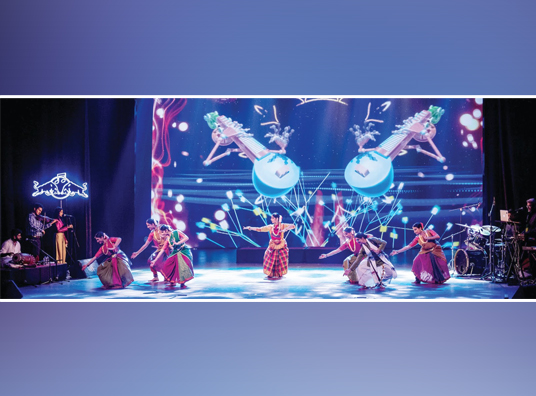
Blending tradition and technology
NEHA KIRPAL
A scene from Antariksha
Sanchar
Antariksha Sanchar—a transmedia dance
opera, staged recently in Delhi and Mumbai, brought together Bharatanatyam and
an upcoming adventure video game named Antariksha Sanchar:
Transmissions in Space. A collaboration between artist Avinash Kumar
(Thiruda) and Bharatanatyam dancer Jayalakshmi Eshwar, Antariksha
Sanchar was based on a fictitious story about Srinivasa Ramanujan’s
dream that leads him to build a vimana (interplanetary vehicle) to travel to
the cosmos.
Presented by Red Bull
Music, the project with hyperglobal progressive ideas, had its inception in an
hour-long performance of Jayalakshmi on Indian
mythology—depicting birds, flights and vimanas way back in 2010 and
a videogame inspired by the cultural richness of south India that Thiruda has
been working on for six years now. An eclectic fusion of Carnatic music, Indian
classical dance and video games, the protagonist of the story is Srinivasa
Ramanujan, who expounded some of the world’s most important mathematical ideas.
Jayalakshmi Eshwar played Sita, Ramanujan’s mother and S. Sushmita played
Ramanujan.
The music was set by
Hyderabad-based Murthovic, a DJ and electronic music producer from Red Bull
Music with two decades of experience in the field. The rest of the music
ensemble consisted of Raghuram Hari (mridangam), Shri (vocals), Abhijit Gurjale
(violin), Hitesh Kumar (drums) and Yanni (piano).
Divided into five
segments, act one began with an elegant salute to Lord Ganesa who resides in
the wish-fulfilling Kalpavriksha; this was accompanied by animated visuals and
psychedelic tunes denoting Ramanujan’s mind.
A man from the future
enters an old palace where he finds an ancient book. The scene shifts to 1913
to the beautiful temple town of Madurai where people are celebrating the annual
Navagraha festival hailing the nine planets of the solar system. A troupe of
five dancers perform in apt synchronisation against the backdrop of
digitised images of Madurai’s landscape—its trees, water bodies, fields, city
landmarks and temples highlighting the city’s colours, carvings and paintings.
The images are interspersed with dialogue, dance, visuals, music and
expressions that carry the story forward. A saint appears in Ramanujan’s dream
and tells him that he is to embark on a cosmic voyage in a vimana. His mission
would be to align the nine cosmic planets.
In The Myth (act
two) Sita tells her son stories of space travel mentioned in ancient Indian
texts like the Vaimanika Sastra, a Sanskrit text on
aerospace technology that describes vimanas as advanced aerodynamic
flying vehicles. She also narrates Lord Hanuman’s supernatural flying
abilities.
Act three provides
the audience a visual treat of the flight dance. Sita tells her son about a
mystical place called the Vimana temple which abounds in sculptures. The
dancers depict the sculptures through movements and poses, such as the
fluttering of feathers and the peacock vimana.
In act four, The
Contraption—Ramanujan’s magical vehicle is created with the help of the two
engines of fire and water—philosophically the two elements that help to balance
body, mind and soul. The dancers perform the Suryanamaskara—to depict fire as a
source of energy to initialise the vimana. Water, which equates
calmness and reflection, is used as a metaphor for peaceful meditative cooling
through unwavering focus and centering. The harmony of fire and water leads to
the creation of the vimana. A trance-like dance sequence for an EDM in fast
tempo is accompanied by kaleidoscopic images in the background. The use of the
corresponding red and blue lights accompanied by rhythmic dance movements and
foot-tapping musical beats in this sequence is spectacular.
The final act,
called The Pilgrimage, shows the vehicle taking off into outer
space—through the sky embellished with millions of stars and fabled creatures,
such as dinosaurs, aliens, gods and goddesses—and finally landing back on
earth. The enthusiastic dance ensemble comprising the entire troupe and the use
of vibrant colours had the audience applauding Ramanujan’s victory.
Antariksha Sanchar, which plans to
tour south India this year, is a family entertainer—an amalgam of history,
science, mythology, fantasy, dance, music, art and theatre. An original idea,
it has made a unique attempt to communicate stories of the past to the next
generation through technology. It is also a tribute to the city of Madurai—its
history and heritage; legends and landscape. It endeavours to convey the
message that each individual has to discover his or her own ‘vimana’ to find
satisfaction and a sense of fulfilment in life.
(The author is a freelance writer)
Celebrating armed forces week
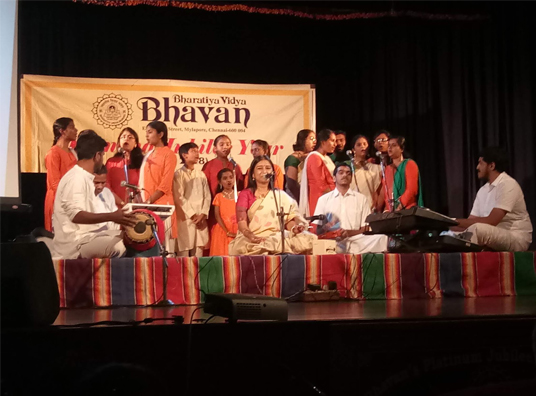
Bharatiya
Vidya Bhavan, Chennai celebrated Armed Forces Week (1-7 December) by inviting
Lt Gen R.K. Swamy as the chief guest at a concert on 5 December 2018. R.K.Swamy
spoke briefly on the significance of the armed forces and why it is important
for citizens to recognise their selfless service.
In a
refreshing deviation from the usual line of carnatic music concerts, the
evening saw an excellent presentation of patriotic songs by Devi Neithiyar and
group (disciples of T.V. Gopalakrishnan) rendering select numbers in various
Indian languages and genres. What was even more interesting was a power point
presentation that explained the meaning of the songs. Her voice had an
incredible range and felicity and won the hearts of the audience. Devi, with
her team of accompanists and choir members succeeded considerably in
bringing out the spirit of the compositions.
At the end, a
member of the audience indeed shared his personal appreciation by excitedly
remarking, “We are here enjoying our freedom because of the army that
safeguards us and protects us from hostile environs.”
The
dignitaries sat through the entire recital much to the enthusiasm of the
artists and a discerning audience.
Jai Bharatiya
Vidya Bhavan for the laudable initiative!
S Sivaramakrishnan
Gift of a lifetime
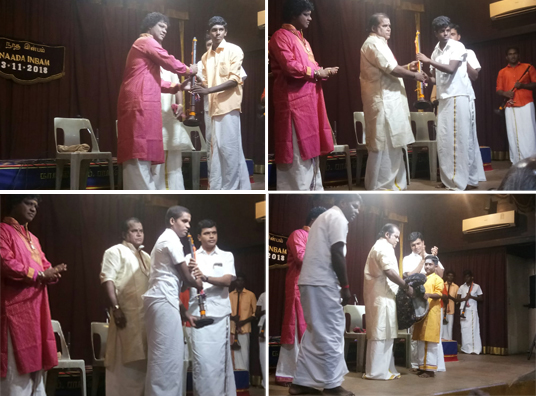
Parivadini – a trust for promotion of
music and arts presented new instruments (three nagaswarams and a tavil) to
four young teenagers, genuinely in need of assistance, at a function
organised by Lalitha Ram in Chennai.
B. Balaganesh (16)
and E. Chandrasekar (18) disciples of nagaswara Prakash
Ilayaraja (the former is also a student at the Government music school in
Vizhuppuram and G. Velmoorthy (17) learning under Chinnamanoor Vijaykarthikeyan were the
three to receive Nagaswaram along with all its accessories. V.
Gobeeswaram (9) the youngest of the four received a tavil to pursue
his lessons under Thirurameswaram B. Radhakrishnan.
The little boy
was the cynosure of all eyes. The students received the instruments from
Yazhpanam Balamurugan, Sri Kalyanasundaram and Sri Prakash Ilayaraja, stalwarts
in their field.
What is
interesting to note is that their interest in these particular traditional
instruments which do not fall under mainstream kutcheri repertoire.
Practiced by traditional families in temples. These instruments are more
confined to an agrarian rural set up. It is rare to find someone
keen to take these instruments as a profession.
The financial
background of these boys restricted them to purchase an instrument for regular
practice at home. Spotting their keen learning quest, this timely assistance
towards deserving aspirants is definitely a well thought action to help them
continue their pursuits.
Truly gifts of a life time!
S
Sivaramakrishnan
Attendance awards 2018
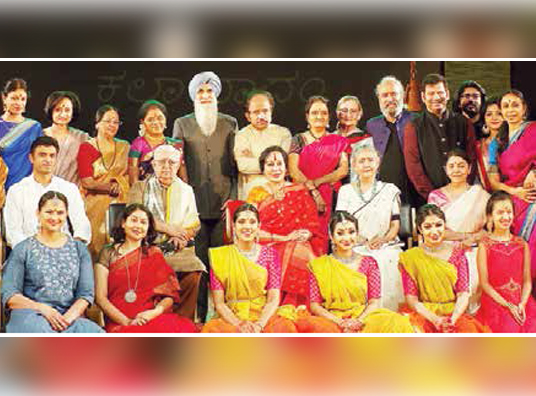
Attendance
annual awards 2018, the brainchild of
Ashish Khokar, was hosted and held in collaboration with Nadam (Director,
Kathak artists Murali Krishna and Nandini Mehta) during the festival organised
23-25 November at ADA Rangamandira, Bengaluru. The awards for 2018 were presented
by Chiranjiv Singh, former Ambassador to UNESCO, Additional Chief Secretary and
chairman of the award’s jury. The Maya Rao Lifetime Achievement Award was
presented to veteran Odissi and Bharatanatyam exponent, guru and arts activist
Sonal Mansingh; Mohan Khokar Dance Academics Award to veteran writer and
musicologist B.M. Sundaram;Rukmini Devi Significant Contribution to
Bharatanatyam Award to senior dancer-guru Sucheta Chapekar; Uday Shankar
Choreography Award to senior dancer and choreographer Daksha Sheth; and Ram
Gopal Best Male Dancer Award to Bharatanatyam dancer Parshwanath Upadhye.
Sreshta Sangita Seva Lahiri award

Jayalakshmi Balakrishnan, who runs Naada Inbam (Raga Sudha), received the Sreshta Sangita Seva Lahiri award instituted by Indira Ranganathan Trust from Spencer R. Venugopal in recognition of her yeoman service to promoting music, on the occasion of Women’s Day, 1 March 2019 in Chennai. It was followed by a concert of vidushi Suguna Varadachari.
Sangeeta Vedanta Dhurina Award

The violin duo Ganesh- Kumaresh, was conferred the title Sangeeta Vedanta Dhurina, instituted by Sri Rama Lalitha Kala Mandira, from Yadugiri Yathiraja Narayana Ramanuja Jeeyar, at the Bangalore Gayana Samaja auditorium in Bengaluru. The award comprises one lakh rupees for each artist along with silver medals and citations.
The Shivaargya - Sivaratri festival
The Shivaargya - Sivaratri festival was organised at Ganesa Natyalaya, New Delhi on 3 March 2019 . It was a day-long celebration (10 am to 6 pm) comprising performances by young male classical dancers, and the honouring of male classical dance gurus and scholars of Delhi. Guru Saroja Vaidyanathan also received the Best of India Records Certificate from adjudicator Binu Joseph for organising classical dance performances continuously for eight hours.
Veena Seshanna Memorial National Award
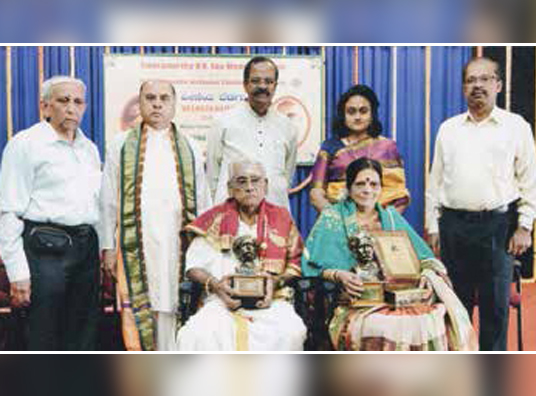
The Amaravathi Lifetime Achievement Award 2018
The Amaravathi Lifetime Achievement Award 2018 was presented to veteran Bharatanatyam exponent and guru Chitra Visweswaran during the Amaravathi Nrityotsav organized by Nataraj Music and Dance Academy, Visakhapatnam.
Uniting communities through music and dance
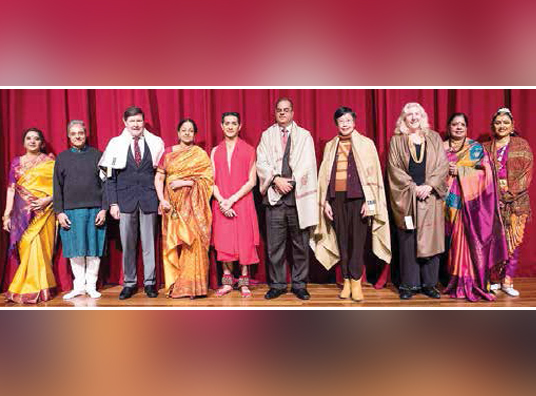
Global Achievement Award for Radhika Shurajit
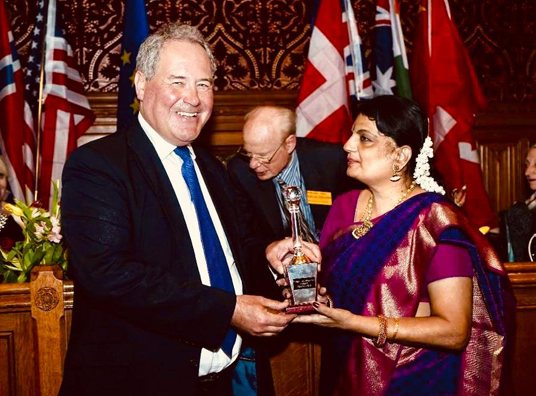
Pravasi Bharatiya Samman
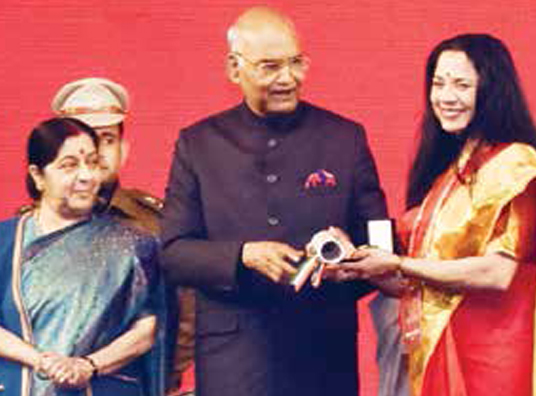
Senior Kathak exponent and teacher, Malini Ranganathan,
French national of Indian origin, was conferred the Pravasi Bharatiya Samman by
the President of India, Ram Nath Kovind on 23 January 2019 in Varanasi, for her
“extraordinary contribution in academics and arts”. The Samman is the highest
honour conferred on the occasion of the Bharatiya Pravasi Divas, on members of
the Indian diaspora for their contribution in diverse fields. Fluent in
English, Hindi, Urdu and Tamil, Malini who has trained both in the Lucknow and
Jaipur gharanas of Kathak, has performed in several prestigious festivals and
has also convened and curated several events in France.
A celebration of nature as teacher
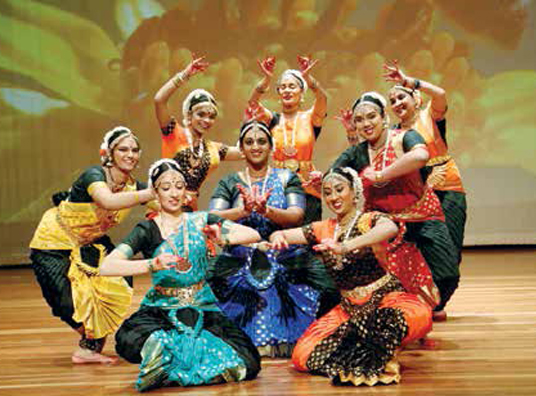
Nature, the great Teacher, a dance musical on the story of Lord Dattatreya,
was conceived and produced by Narmatha Ravichandra to mark the completion of 25
years in Australia as a musician (vocalist and violinist), dancer and choreographer
(Bharatanatyam). She is successfully running the Sruthi Laya Kendra and the Bharatha
Choodamani arts schools in Australia which can boast of hundreds of students.
The production was based on the key learnings derived from
the 24 aspects of nature—acknowledged as his gurus—by Dattatreya in the Bhagavad Gita. In his
final teaching to his friend Uddhava, Lord Krishna narrates the story of
Dattatreya. As the story goes, while Dattatreya was wandering happily in the
forest, he met King Yadu who asked him the secret of his happiness and the name
of his guru. Dattatreya told him that the atman
alone was his guru, and yet, he had
learned wisdom from 24 individuals, who he considered his gurus.
This story was presented with over 30 dancers and was
complemented with interactive digital displays on the backdrop. Flautist and
composer, B.V. Balasai, created an interesting amalgam of Indian music with
Western instrumentalists and the entire production was choreographed to only instrumental
music without lyrics. D.A. Srinivas devised the rhythmic patterns and konnakol.
The secular theme, the seamless choreography combined with lively music, won the hearts of the audience. Narmatha and Ravi Ravichandra, who took on the responsibilities of artistic director and production director respectively for Nature, the great Teacher, are known for their yeoman service in the promotion and enrichment of Indian classical arts in Melbourne, Australia.
Honouring her guru Krishna Kumari Narendran

Parvathi Ravi Ghantasala, Artistic Director and Managing Trustee
of Kala Pradarshini, celebrated 40 years in dance by honouring her guru Krishna
Kumari Narendran on 20 January 2019 as part of the Kala Pradarshini Natya
Festival. She also honoured several dancers, musicians and allied artists who
were associated with her in her 40-year dance journey. The awards were
conferred in the presence of veteran dancer-scholar Padma Subrahmanyam.
Remembering MDR
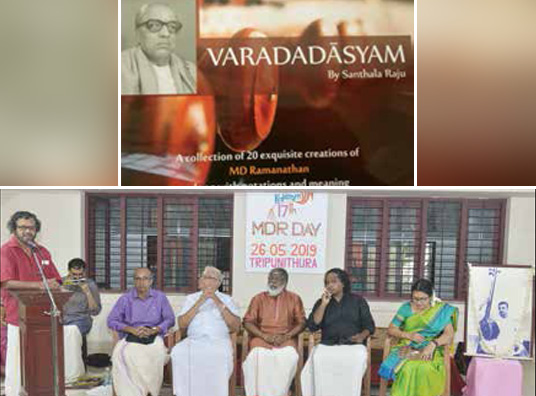
This year too,
‘MDR Day’ was organised by Krishnamurthi under the banner of Kedaram, at
Tripunithura in Kerala. Chief guest, Palghat T.R.
Rajamani, spoke about the Brahma layam innate in M.D. Ramanathan’s music.
A ‘Rasikas Forum’ on MDR’s music was moderated by musicians P. Subramaniam and
Sreevalsan J. Menon.
The first copy of
Varadadaasyam—a book containing 20 compositions of M.D. Ramanathan —notated by Tripunithura-based
musician Santhala Raju, was presented to veteran vidwan P.R. Kumara Kerala
Varma. The evening concert featured the Mysore Brothers
(violin) with K.V. Prasad (mridangam).
Raam Manikandan gets Bal Shakti Puraskar
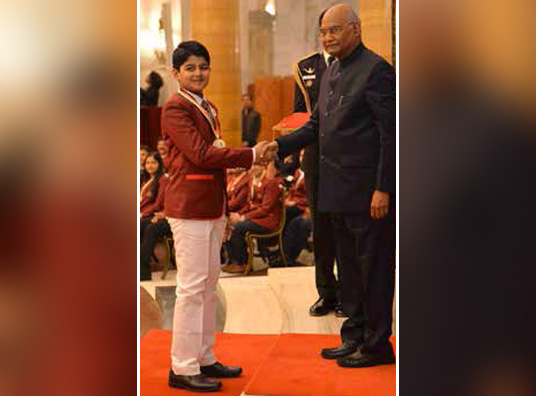
President Ram Nath Kovind presented the Bal Shakti Puraskar 2019
awards earlier this year. Twenty-six awardees were chosen from amongst 900
applications in the field of innovation, social service, scholastic, sports,
art & culture and bravery. Selected in the category of art & culture –
classical music – was Chennai based Raam Manikandan. Twelve-year-old Raam, is
studying in class 8 in Padma Seshadri Bala Bhavan, Siruseri, Chennai. He learns
Carnatic music from Prof. P.P. Ramakrishnan (Retired. Principal of the Chembai Memorial
Music College, Palghat, Kerala), and mridangam from Mysore Sai Shiv of Guru
Karaikudi Mani School. Raam has also completed the electronic keyboard final
(8th) grade exam conducted by Trinity College, London, and is one of the
youngest in India to have secured it with distinction. Among his other accomplishments,
Raam has also received the Kalai Ilamani Award (Young Artist award) from the Government
of Tamil Nadu.
Trutpraj Atul Pandya from Maharashtra and
Vinayaka M from Karnataka are the other two children who have been awarded the
Bal Shakti Puraskar under this category.
Statue of M.S. Subbulakshmi unveiled
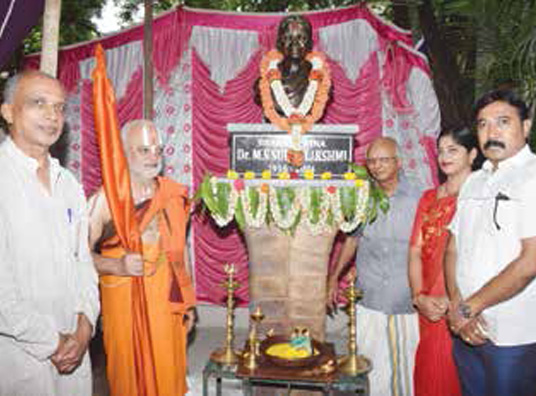
A statue of the late M.S. Subbulakshmi was unveiled by the Jeeyar of
the Yathiraja Mutt, Melukote, at Sri Rama Lalitha Kala Mandira, Bengaluru
recently, in the presence of Lakshmi Umesh, Corporator of BBMP and G.V. Krishna
Prasad, Hon. Secretary of Sri Rama Lalitha Kala Mandira.?
Guru HR Keshavmurthy Centenary
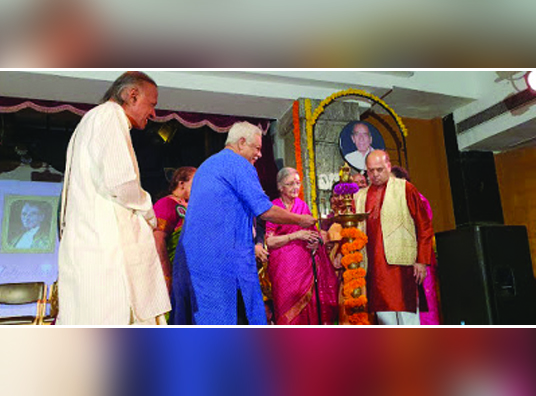
Taking music to school children
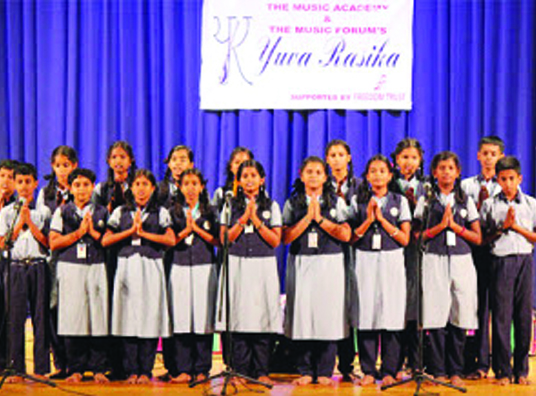
(News & Notes)
Music Forum, in association with The Music Academy, organised a mega workshop titled ‘Yuva Rasika’, for school students, at The Music Academy, Madras, on 31 August 2019. Now an annual feature, Yuva Rasika has become a sought after event for school students. Twenty schools from across the city, and as far as from Vellore and Sholingur, participated.
To Read more click the link : http://srutimag.blogspot.com/2019/10/news-notes.html
Vilayat Khan memorial festival in Shimla
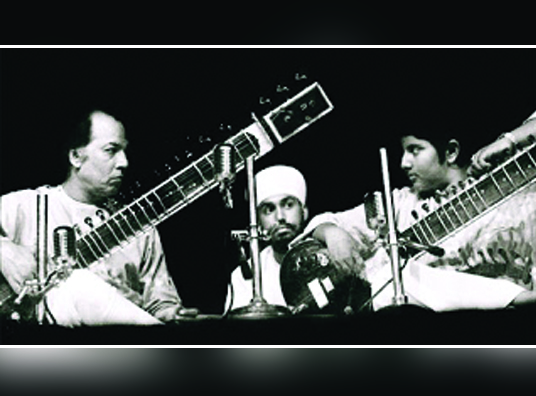
To read more click the link : http://srutimag.blogspot.com/2019/10/vilayat-khan-memorial-festival-in.html
Guru Purnima Utsav in Mumbai
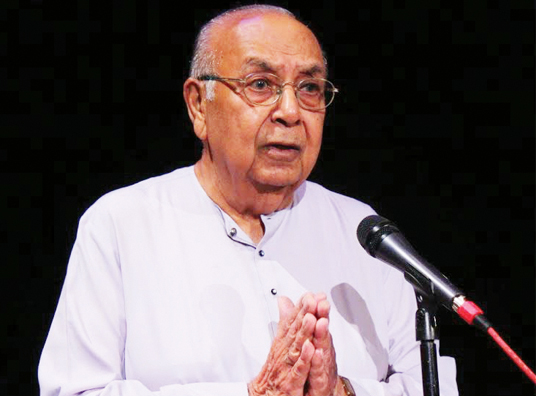
Book with compositions of the Tanjai lineage
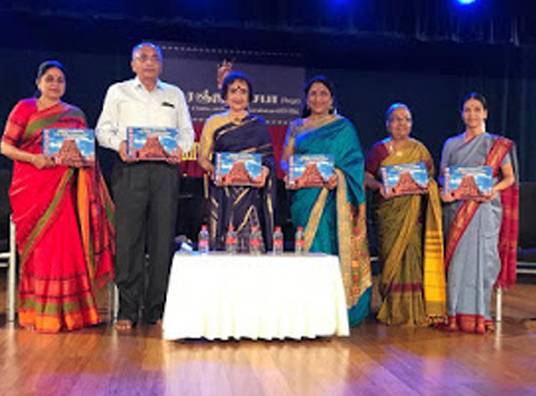
A book titled "Tanjai Naalwarin Bharata Sangeeta Varnamalika", edited by K.P.S. Chinnaiah (son of the late K.P. Sivanandam) and published by R.R. Sabha and Rukmini Arts Academy, was released on 5 October 2019 at the R.R. Sabha in Chennai. Veteran Bharatanatyam exponent and torchbearer of the Tanjavur bani, Vyjayantimala Bali, released the book and presented the first copies to A.R. Santhanakrishnan (President, R.R. Sabha), Aruna Ranganathan (Trustee, Rukmini Art and Music Trust), Bharatanatyam dancer Nartaki Nataraj, Rama Kousalya (musicologist and retired Principal of Tiruvaiyaru Govt. Music College), and S. Janaki (Editor-in-Chief, Sruti magazine). Music and dance concerts and a lecture were also organised on the occasion.
Special edition on Maharaja Jayachamarajendra Wodeyar
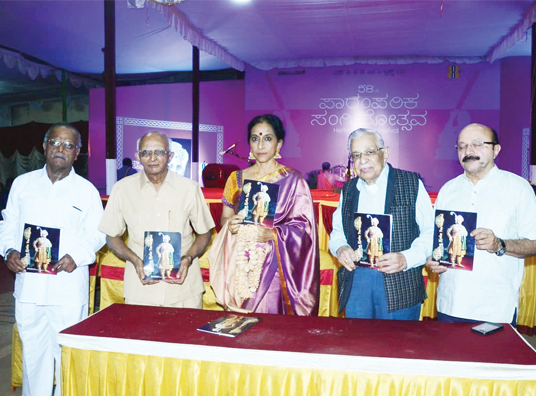
Lalitha Kala Tarangini’s special edition on Maharaja Jayachamarajendra Wodeyar was released by Carnatic musician Bombay Jayashri in Mysore to mark the composer-king’s centenary.
Dr. V. Raghavan's book released
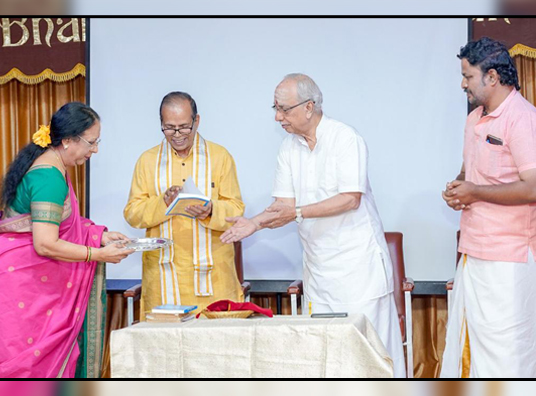
The book titled Studies in Abhinavagupta’s Works by Dr. V. Raghavan was released by Prof. S. Kannan (Chief Professor, IIT Madras) in the presence of R. Kalidas and Nandini Ramani of Dr. V. Raghavan Centre for Performing Arts, Chennai. It was followed by a lecture by scholar Dr. G. Sankaranarayanan, on ‘The Number of Rasas of Dr. V. Raghavan based on Abhinavagupta’s Rasa Theory’. The Raghavan Centre conducted Pitru Vandanam at the Bharatiya Vidya Bhavan Mini Hall on 22 August 2019 to celebrate Dr. Raghavan’s 111th birth anniversary.
Raga Identification Competition 2019
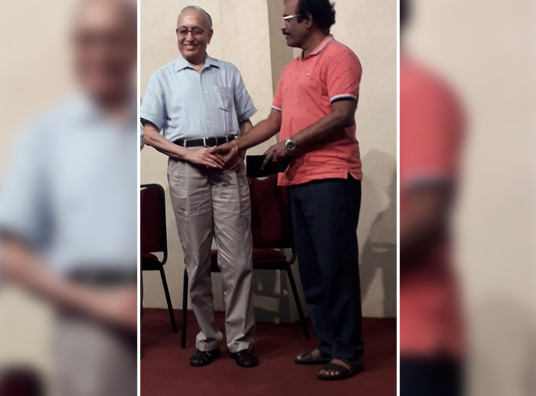
C. Ramakrishnan, an avid rasika of Carnatic music, won the Raga Identification Competition 2019, organised by The Music Academy in association with TAG Corporation and Ramu Endowments. Held on 20 October 2019 at The Music Academy, C. Ramakrishnan answered a record 38 out of 40 questions! He was also awarded a cash prize of Rs. 5000. Hearty congratulations to our correspondent C. Ramakrishnan on this splendid win!
HYDERABAD BROTHERS RECEIVE SANGEETA KALA SAAGARA
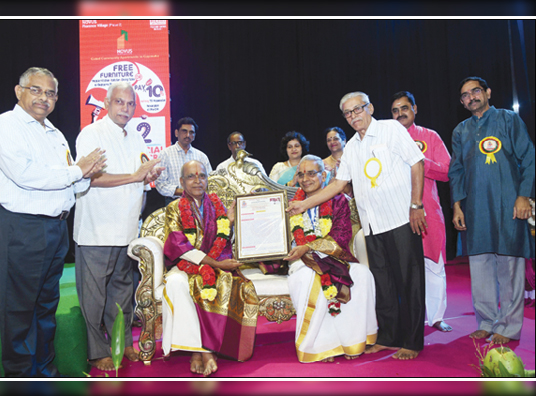
Hyderabad
Brothers D. Seshachary and |D. Raghavachary were conferred the Sangeeta Kala
Saagara award by Visakha Music Academy, Visakhapatnam, on 25 November 2019.
VEENA SESHANNA MEMORIAL AWARD
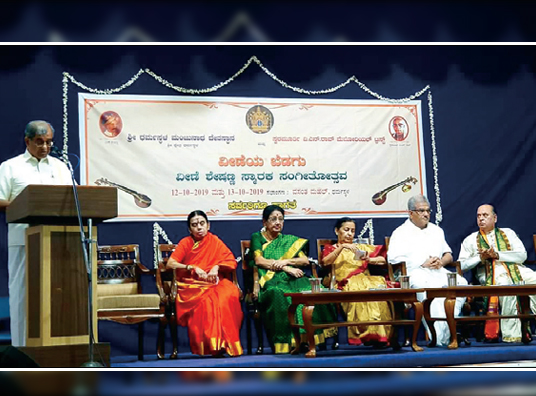
The Veena
Seshanna Memorial National Award for 2019 was presented to vidushi A.
Kanyakumari, and the Swaramurthy V.N. Rao Memorial Award to vidushi Neela
Ramgopal, at Dharmasthala on 23 October 2019. A two-day music festival ‘Veeneya
Bedagu’, featuring 30 musicians, was organised jointly by Sri Manjunatha Temple
and Swaramurthy V.N. Rao Memorial Trust. Seen in the picture : (L to R) A.
Kanyakumari, Neela Ramgopal, Hemavathy Heggade, Dr. Veerendra Heggade, Prof.
Mysore V. Subramanya.
SANGIT KALA KENDRA AWARDS
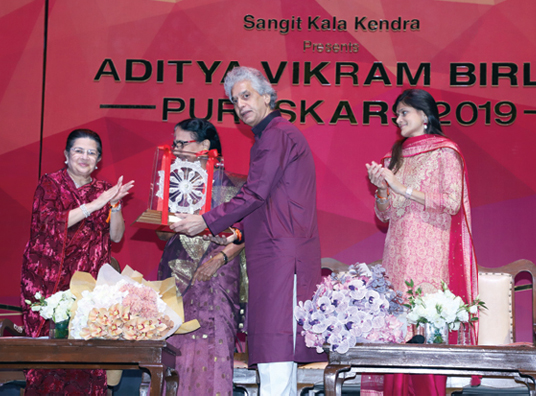
The Aditya
Vikram Birla Kalashikhar Puraskar was presented to renowned tabla maestro,
Ustad Zakir Hussain at the 24th edition of the Sangit Kala Kendra awards
function held in Mumbai. Two young instrumentalists, Ragini Shankar (violin)
and Abir Hossain (sarod) were awarded the Aditya Vikram Birla Kalakiran
Puraskars. Eminent violinist N. Rajam was the chief guest on the occasion and
presented the awards. The awards have been instituted by the Birla family in
memory of Sangit Kala Kendra’s visionary Founder, Aditya Vikram Birla. Fazal
Qureshi received the award on behalf of his brother Zakir Hussain.
SUMITRA CHARAT RAM LIFETIME ACHIEVEMENT AWARD

The veteran
dancer and Member of the Rajya Sabha, Sonal Mansingh was conferred the Sumitra
Charat Ram Lifetime Achievement Award 2019. The award was given by the Shriram
Bharatiya Kala Kendra, renowned organisation for art and culture in New Delhi.
The management of Shriram Bharatiya Kala Kendra instituted the Sumitra
Charat Ram Award for Lifetime Achievement in 2010, which is given annually to
an eminent personality in Indian classical music or dance. The first recipient
of the award was Pandit Birju Maharaj. This year Sonal Mansingh received this
award from Birju Maharaj in the presence of Shobha Deepak Singh, Director of
the Kendra.
The award ceremony was
followed by a dance presentation by Dr. Sonal Mansingh.
AWARD FOR VAINIKA JAYANTHI KUMARESH
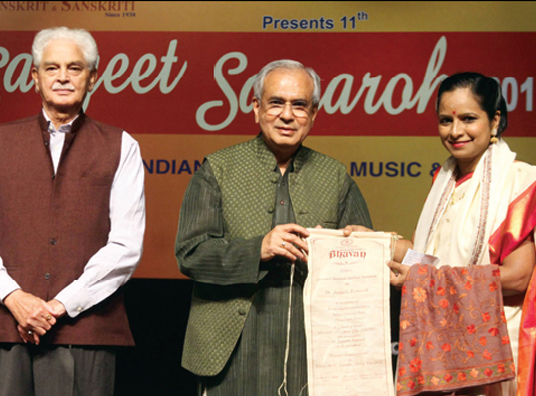
Renowned
vainika Jayanthi Kumaresh was conferred the Sangeet Shikar Samman by Bharatiya
Vidya Bhavan, New Delhi in recognition of her distinguished services to Indian
classical music, especially the Saraswati Veena. Chief guest, Vice Chairman of
NITI Ayog,Rajiv Kumar presented the award to Jayanthi Kumaresh. The award
instituted in 2010 has been bestowed on eminent artists in the last nine years.
The award includes a purse of rupees one lakh, a citation and a shawl. Some of
the earlier awardees are Hariprasad Chaurasia, Girija Devi, M.
Balamuralikrishna, Yamini Krishnamurti, T.N.Krishnan, and Jasraj to name a few.
Jayanthi is the youngest recipient of the Bharatiya Vidya Bhavan Annual Award.
As a torchbearer for the
‘national instrument’ of India, Jayanthi Kumaresh is an articulate musician who
is unafraid of breaking new ground with her music. Not confining the subtle
veena to the Carnatic music stage, she has taken it to new and diverse
audiences through cross-genre collaborations.
Bharatanatyam school celebrates 50 in Quebec
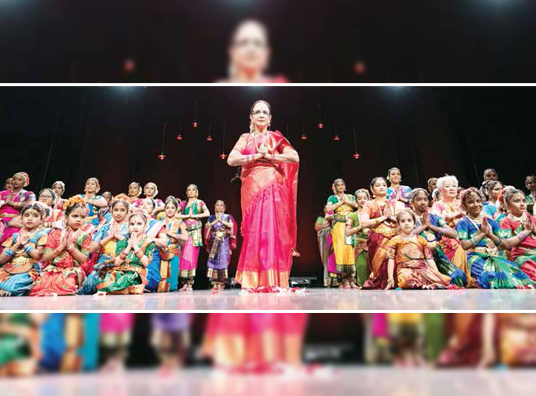
Being an engineering professor, I am not a music or dance critic by any standards, but I do get attracted to good music or artistic performance whenever available in the area where I live, particularly music concerts and dance performances organised by various associations, schools from the Indian diaspora.
My introduction to Bharatanatyam was from Priyamvada Sankar during the arangetram of one of her students more than four decades ago, for which her husband invited me. He was my roommate at the Indian Institute of Science in Bangalore, and in 1974, I immigrated to Canada to join as a Professor at the Universite du Quebec a Trois-Rivieres in Quebec, Canada. Priyamvada, through her wellprepared explanations on the format of a standard Bharatanatyam, made it easy to understand this beautiful art form. Her dedication and her introduction of this art form into the Québec mosaic fifty years ago is a commendable achievement. The 50th anniversary of the Priyamvada Sankar School of Bharatanatyam was celebrated on 5 October 2019 at the College Durocher Auditorium, Saint-Lambert, Quebec, Canada. Priyamvada was one of the earliest, prime students of the illustrious guru T. Balasaraswati, about whom I have heard so much in my youth.
The impressive souvenir/ commemorative album, aptly named Natyam 50, brought out for the occasion, contained numerous meticulously preserved photos from the earliest days of Priyamvada as a child dancer as well as articles relating to her school, her awards, and on her numerous associations with various dance schools in North America and India. With her background as a Sanskrit scholar, in addition to being a Bharatanatyam dancer and teacher, Priyamvada is also associated with various organisations like the Interfaith Council for several decades.
The grand event was wellcoordinated by Priyamvada’s two sons, with the assistance of a large number of students and their parents. There were speeches by invited guests and a couple of parents whose daughters were the second and third graduates of the school who had performed their arangetram more than four decades ago! These speeches were tactfully presented between two items in the programme to enable the audience to pay full attention to the details.
The evening started with a prayer to Lord Nataraja, Raksho Daksha padambujena, composed by the late Dr. V. Raghavan, father of Priyamvada. This was rendered live by T.S. Ranganathan, a family member who came from India to participate in this celebration.
The traditional prayer songs accompanying the opening dances
were offered first to Lord Ganesa and then to Lord Muruga. An interesting format
of the dance repertoire was chosen for this occasion, which included traditional
items such as jatiswaram, padam on Lord Nataraja, and tillana; a beautiful
ashtapadi of Jayadeva on Lord Krishna was also presented. As this anniversary
coincided with the auspicious Durgashtami day during the Navaratri festival,
befittingly a Tamil masterpiece – Sri
Chakraraja – a melodious song on Devi was chosen
and performed gracefully by three senior dancers. The overall choice of songs,
mostly in Sanskrit and Tamil, to suit the Navaratri celebrations, made an
enjoyable impact. Muthuswami Dikshitar’s Ananda
natana prakasam, which was performed by senior graduates
from New York, also received good response.
The fitting finale of the celebration was the graceful abhinaya performed by Priyamvada Sankar for the famous song Maitreem bhajata, composed by Dr. V. Raghavan and blessed by the Paramacharya Sri Chandrasekharendra Saraswati of the Kanchi Kamakoti Peetham.
Another special aspect of this celebration was the
remarkable camaraderie between the students, their parents, and the
appreciation and admiration for their guru Priyamvada Sankar. Their feelings
were sincere and heartwarming, a
trait that is becoming rare in th present day. The fact that the idea of this
celebration was initiated with enthusiasm by more than sixty past graduates and
current students bears witness to the guru-sishya tradition, return in the form
of gratitude, and respect as ‘dakshina’ by the disciples to the guru. The fact
that many of Priyamvada’s past students who hold high positions in their
professions, despite their numerous commitments, all of them found time to come
from long distances for rehearsals and participate actively on the stage, is
indeed most commendable.
One notable observation was the presence of ex-Provincial
Minister of Health and Current MLA in our Quebec National Assembly, Dr. Gaetan
Barrette, a special guest for this occasion. He witnessed his first
full-fledged Bharatanatyam performance and remained appreciative till the end
of the celebrations that lasted more than three hours.
‘Natyam 50’ was a spectacle that we enjoyed celebrating the
remarkable milestone in Priyamvada’s artistic endeavour, in the company of an adoring
audience, numerous old and new friends, family, loyal students, and committed
parents. This is the legacy that Priyamvada Sankar has achieved in the past 50
years of her promotion of the Tanjavur bani of Bharatanatyam in North America.
Prof. V. RAJAGOPALAN
SHRESHTHA BHARAT SANSKRITI SAMAGAM
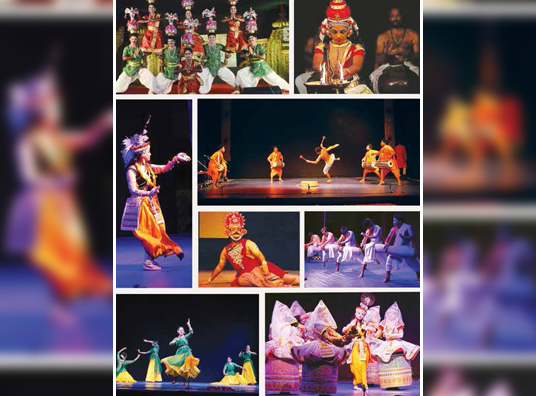
A national cultural confluence
The Shreshtha Bharat Samskriti Samagam is a unique series of festivals featuring music, dance, drama, folk, tribal arts, puppetry and allied traditions, organised by the Central Sangeet Natak Akademi, under the advice of the Prime Minister, in six directions of India, including smaller cities and towns. The confest is the brainchild of Chairman Shekhar Sen, whose desire it is to celebrate all branches of the performing arts at one venue. Apart from presenting these art forms through performances, seminars were also held wherein paper presentations by scholars of the respective forms were included. These have been documented and will be brought out as a volume for the benefit of future generations.
The mammoth project was launched at Bhubaneswar in Odisha
(10-14 July 2018), and its success gave SNA enough impetus to hold the next
events in different parts of the country: at Ahmedabad, Gujarat (west) in September
2018; Amritsar, Punjab (north west) in November 2018; Guwahati, Assam
(north-east) in December 2018; and Tanjavur in Tamil Nadu (south) from 10 to 14
September 2019. The sixth one will probably be held at Indore in Madhya Pradesh
(central India).
The fifth edition of the confluence was held in
collaboration with the South Zone Cultural Centre, in Tanjavur—the ancient
capital city of the Cholas, where culture flourished. This edition too covered
music, dance, drama, folk, tribal arts, puppetry, and allied traditions. The pattern
followed was also the same on all five days. The morning sessions, from 10.30
am to 1 pm, were devoted to seminars and discussions by stalwarts, while the
evenings were devoted to performances by veterans. The topic for discussion was
‘The past, present, and future scenario of the performing art forms’. Some of the
senior musicians who participated were Pushpraj Koshti, Neyveli R.
Santhanagopalan, Chitravina N. Ravikiran, Kaivalyakumar, Lalgudi G.J.R.
Krishnan, and Neela Ramgopal.
On the second day, stalwarts spoke on folk and tribal arts.
Indumati Raman gave a spellbinding talk on the Bhagavata Mela tradition
practiced and performed at Melattur on Narasimha Jayanti every year. M.V. Shimhachala
Sastry, Harikatha exponent from Andhra Pradesh, presented an erudite and
interesting paper on endeavours for the sustenance and development of the art
form. Anupama Hoskere from Bengaluru was articulate about the puppet tradition
of Karnataka, which encompasses several art forms, and is a rich repository of
the social history of the land. Atashi Nanda Goswami spoke of the past,
present, and future of glove puppets in West Bengal.
In the evening, there was a shadow puppet show of Karnataka
on the theme of Gautama Buddha, to give the audience a taste of puppetry.
Among the speakers on dance were veterans Kanak Rele, who gave
a glimpse of her work in the revival of Mohini Attam, and Saroja Vaidyanathan,
who spoke about the past, present, and future of Bharatanatyam. Senior
Kuchipudi dancer-teacher Vyjayanthi Kashi, traced the history and changing
patronage of dance as well as the present scenario, while Kuchipudi and
Bharatanatyam exponent from Gujarat, Smita Shastri spoke about the evolution of
Kuchipudi, the need to preserve, propagate tradition, and called for more
interaction between generations.
Zafar Sanjari spoke on Nautanki, and Murari Rai Choudhury
from West Bengal spoke on theatre. The topic of drama was taken up again on the
last day where Deepak Karanjikar (Maharashtra), K.G. Krishnamurthy (Karnataka),
R. Raju (Puduchery), Padamshri Josalkar (Goa), Naresh Chandra Lal (Andaman and
Nicobar) and Debasish Mazumdar (West Bengal), gave their valuable inputs. Interestingly,
Karanjikar threw light on the history of the Marathi Natya Sangeet tradition.
The performance segment included choral music by the Madras
Youth Choir, a Carnatic violin concert by veteran M. Chandrasekharan—both from
Tamil Nadu, and Hindustani vocal maestro M. Venkatesh Kumar from Karnataka.
Shimhachala Sastry presented Harikatha, Khirod Khakhlari of Assam provided a
glimpse into the tribal dance of the Bodos, and Ravi Kumar of Telengana performed
Oggu Dolu with his troupe. Legendary T.A.R. Nadi Rao performed the rare poikkaal kuthirai attam (dummy
horse dance) along with N. Jeeva Rao of Tamil Nadu.
Jawaharlal Nehru Manipur Dance Academy, headed by Rajdhari K.
Jadu Singh, presented a mixed bag of breathtaking pung cholom, dhol cholom, and vasant ras. The team
from Kathak Kendra, Delhi, led by senior artist Rajendra Gangani, presented the
technique of Kathak in all its aspects.
The Dogri play Ghumayee,
directed by Balwant Thakur of Natrang, Jammu,
was a poignant presentation about a bride who refuses to blindly bow down to
orthodox traditions. Bhasa’s Karnabharam, a Sanskrit play, directed by K.N. Panikkar of Sopanam
Institute of Performing Arts and Research Centre, Kerala, was a gem presented
with much sensitivity, bringing out the greatness of the protagonist, who in
spite of being a brave warrior was led by circumstances to accept defeat.
Kathakali was used abundantly in the drama.
Kapila Venu, Director, Natana Kairali Research Training and
Performing Centre for Traditional Arts, Irinjalakuda, and an exponent of both Nangiar
Koothu and Koodiyattam dramatised Kamsavadham
in Koodiyattam style. She narrated the story
from Devaki’s point of view and also wove in the navarasa. Since it was held in
the open air, with bright electric light outsmarting the glow of the
traditional oil lamp, the show was somewhat marred.
Rounding up the Tanjavur Samagam, Aruna Sairam,
Vice-Chairman of the Central Sangeet Natak Akademi, said that a common thread
runs in all of us even if we hail from different regions. The deeply
embedded impulses are in our genes,
though we may not be aware of them. She recalled the importance of the
devadasis and the rituals performed by them, as narrated to her by her music
guru T. Brinda. In summing up, she said that every art form goes back to the core
values in each tradition. Over the years, the stories told cannot remain constant;
even if they are reinvented in new forms by new artists, they build character
and unite us as one cultural unit.
The Sangeet Natak Akademi and the Department of Culture hope that the Samagam congregations would go a long way in the furtherance of their mission “to strengthen and propagate all that is living and life-sustaining in India’s culture”.
TAPATI
CHOWDHURIE
Bhaanotsav (Marga Natya)
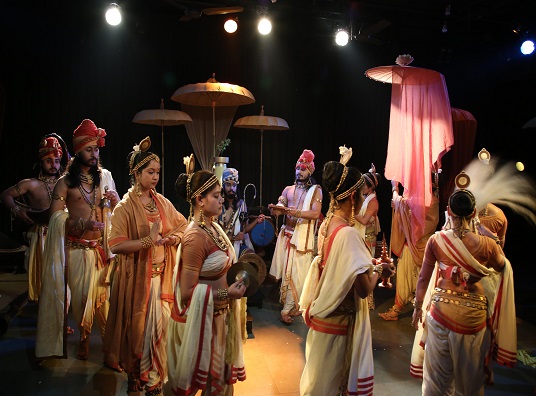
Sathguru Thyagaraja Hamsadhwani Award
Violin maestro M. Chandrasekharan was conferred the Sathguru Thyagaraja Hamsadhwani award on 26 February 2020 by M. Venkaiah Naidu, Vice President of India. The function was hosted by Hamsadhwani at the Kalakshetra auditorium. Present on the occasion were M.Murali, Managing Director, Sri Krishna Sweets, Mohan Parasaran, Senior Advocate, Supreme Court, Ramnath Mani President, Hamsadhwani, D.Jayakumar, Minister, Government of Tamil Nadu, R. Sundar, Secretary, Hamsadhwani, Preetha Reddy, Vice Chairperson, Apollo Hospitals, and Revathi Ramachandran, Director, Kalakshetra. The award ceremony was followed by Kalakshetra's celebrated Maha Pattabhishekam dance drama.
On Nuances of Padams
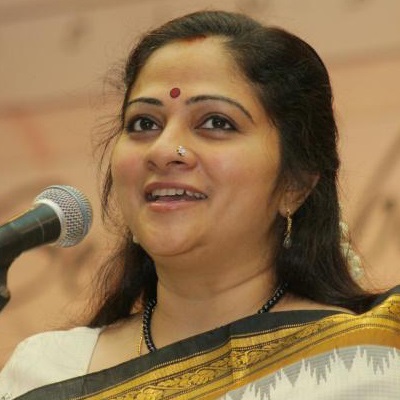
A precious insight into Harikatha

It isn’t on every Saturday morning that you gather at a serene place covered with greenery and a vibrant aura, to get a glimpse into an ancient art form of India. Paathashala, the two-day workshop on the Techniques of Harikatha organised by Charsur Arts Foundation in collaboration with Vijayashri School of Harikatha, and conducted by well-known Harikatha exponent Vishaka Hari was more than enlightening. As a prerequisite, students filled out a short questionnaire on their basic qualifications, knowledge in Sanskrit, scriptures, and musical compositions—some of the essential criteria for participating in this workshop.
Online teeming with classical performances
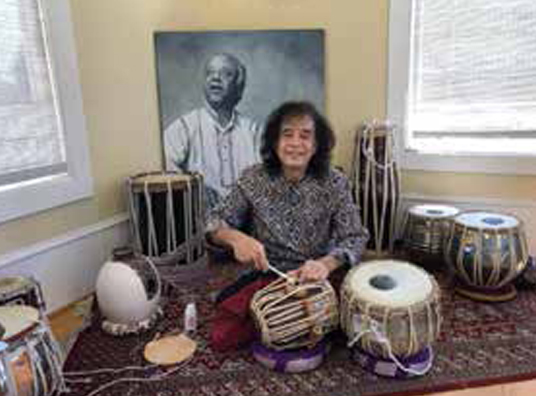
It has been three months since the last “live”
music and dance concerts were held; yet the deluge of online performances
streamed live on various platforms, or recorded in isolation, then streamed
live, are in thousands.
There
are differing views on this phenomenon—seasoned listeners are grateful for an opportunity
to listen to their favourite stars online. “Earlier, where did I get the chance
to peek into Ustad Zakir Hussain’s home in California and see him playing in
his drawing room live!” said an excited fan. (The tabla wizard periodically goes
live on his Instagram account, sometimes even live jamming with other musicians
in other cities; a recent interaction with Anantha R. Krishnan on the mridangam
in Chennai, was thrillingly racy.)
Shilpi
Ravi who listens with as much enjoyment to Carnatic as well as north Indian
music confessed, “There is so much music, starting from 9 am till the night,
one has to literally make time for household chores. Every day Durga Jasraj’s
Utsav interactions with artists followed by a live concert by the same artist
are a must for me, as are the morning Carnatic music broadcast by the Mani
Krishnaswami Academy. One day, I was glued to my screen the whole day during
the weeklong Spic Macay annual online convention where there was music, a talk,
yoga, a film.” Indeed, Spic Macay’s successful attempt to replicate their
annual weeklong immersive festival was impressive—the interaction with doyens
like Padma Subrahmanyam, Chitra Visweswaran, Dr. Karan Singh of note. The
all-night music concerts ended as always at dawn with the vocal dhrupad of Wasifuddin
Dagar who represents the oldest performing line of classical musicians pan
India, being the 20th generation in an unbroken line of musicians.
On
the other hand, the erratic internet connections make the listening experience
of live concerts a disturbed one, with connection interruptions, lag in
transmission and bad sound. There are many who prefer to listen to the concerts
uploaded, amongst others by NCPA, Sangeet Natak Akademi, Prasar Bharati and the
YouTube channels of popular artists which are now being updated regularly. NCPA’s
broadcast of a recent dance performance by the inimitable Malavika Sarukkai and
a themed concert by Ulhas Kashalkar titled Bandish focusing
on great compositions by stalwarts like Anant Manohar Joshi and Ratanjankar
stand out amongst the many interesting performances.
to read the full story click here : http://srutimag.blogspot.com/2020/08/online-teeming-with-classical.html
Malladi Brothers receive Sangeetha Vedanta Dhurina Award
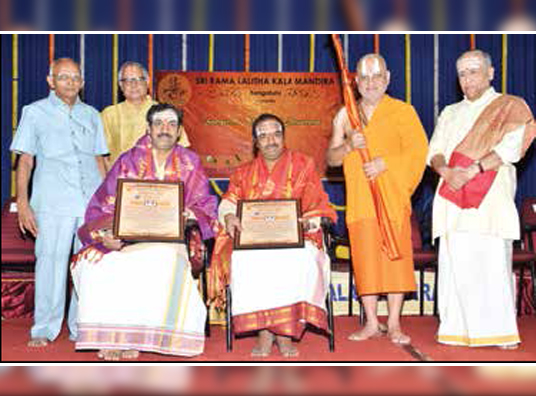
Sri Rama Lalitha Kala Mandira, Bengaluru, presented the G. Vedanta Iyengar Memorial Award to the Malladi Brothers on 19 January 2020. The Sangeetha Vedanta Dhurina Award was presented to the duo by Sri Yadugiri Yathiraja Ramayana Jeeyar, and comprises a cash purse of one lakh rupees each, a silver medal and citation. Also in the picture are mridangam maestro Sangita Kalanidhi Trichy Sankaran, H.R. Yathiraj (president) and G.V. Krishna Prasad (secretary) of Sri Rama Lalitha Kala Mandira.
Awards galore for the Dhananjayans
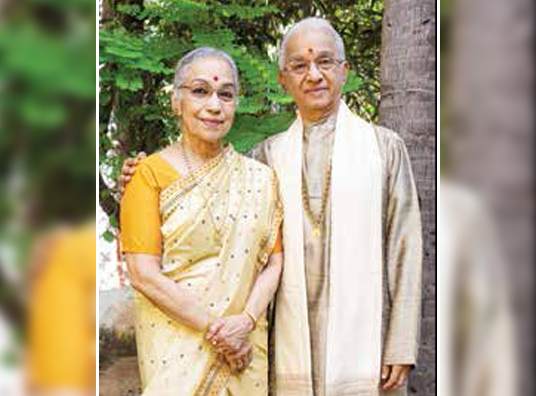
The Dhananjayans were honoured with the title, Bharatmuni Samman by Kalingayana Touryatrikam at Rabindra Mandap, Bhubaneswar on 16 December 2019.
FIRST PERSON
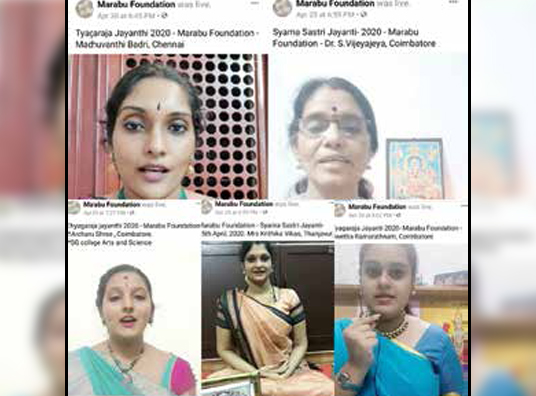
Harnessing technology to tradition
Rama Kousalya
My father used to tell us “Never hate anything. If you do, you may have to live with it forever”. That said, I had to make peace with my contempt for social media and accept it with all the positives it has to offer, especially when it has the world tied up together during these testing times.
Every year, the janma nakshatras of Syama Sastry (1762-1827) and Tyagaraja (1767-1847) are important events at Marabu Foundation, Tillaisthanam. Since its inception, we at Marabu, have had the blessing of paying musical homage to the great saints in their houses. In the month of Chaitra, on the day of Kritika nakshatra (the birth star of Syama Sastry), Marabu Foundation has been presenting a special musical offering at his house in the morning, followed by a concert in the evening at the Tanjavur Bangaru Kamakshi Amman Temple. The celebration has always been preceded by a workshop to teach some of his priceless compositions in the usual gurukula pattern at the Marabu house, Tillasithanam, where the candidates are handpicked and taught free of cost by senior music teachers.
This year too I had elaborate plans in mind to celebrate Syama Sastry’s jayanti. I had planned a musical homage covering all the important sthalas pertinent to him like Kanchipuram, Tiruvarur, Tanjavur and Tiruvaiyaru, while depicting how Bangaru Kamakshi had travelled with the family for more than two centuries until the Maratha ruler brought them all to Tanjavur.
It is said that Syama Sastry’s ancestors were anointed to be the official pujakas of Bangaru Kamakshi Amman (then in Kanchipuram) by Adi Sankara, and fearing the invaders, they fled with the deity from Kanchipuram to several places. It was King Tulaja (1763- 1787), the Maratha ruler of Tanjavur, who brought the family and the deity to Tanjavur, by building the temple and presenting the family with a house and lands for comfortable living.
With regard to Tyagaraja, Marabu had conducted workshops on his kshetra kritis (Lalgudi, Tiruvottriyur, Srirangam and Kovur) four years ago which was facilitated by gurus Leelavathi Gopalakrishnan, Shyamala Venkateswaran, Prema Rangarajan and Bhushany Kalyanaraman. While his ghana raga pancharatnas are popular and widely sung, his kshetra pancharatnas are not sung as groups, although kritis like O Rangasayee, Dharini telusukonti, Ee vasudha andSambho Mahadeva are very popular. It was my keen desire to have these 20 kritis sung by the workshop participants on Tyagaraja’s janma nakshatra (Chaitra masa – Pushya nakshatra, which fell on 30 April 2020), in front of the Rama idol worshipped by Tyagaraja at Varagappaiyyar lane in Tanjavur.
To read the full story click here : http://srutimag.blogspot.com/2020/08/first-person.html
Vidyasundari Bengaluru Nagarathnamma
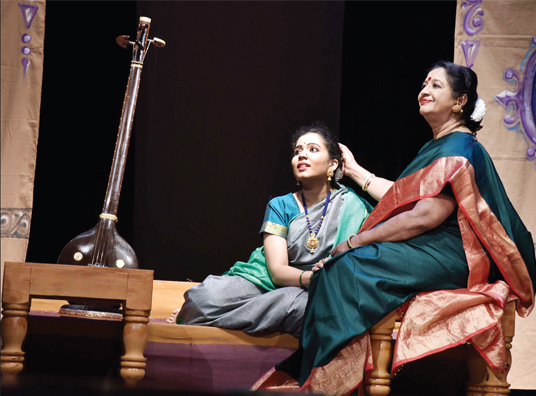
Tribhuvanae ae ae ae, as you listen to the Mukunda Mala stotra sung by Bengaluru Nagarathnamma, you observe an older way of singing. It is at a higher octave, the lines are sharply cut, there is less gamaka and the singing is stronger. Composer Pusthakam Ramaa begins the play, Vidyasundari Bengaluru Nagarathnamma, on the same note, but with softer continuity of lines, adding more body with gamakas reflecting contemporary Carnatic music. The play on Bengaluru Nagarathnamma was premiered on 27 December 2019, at Chowdiah Memorial Hall in Bengaluru.
The opening scene depicts the samadhi of Tyagaraja, with the two groups of Peria Katchi and Chinna Katchi squabbling over the conduct of the saint’s aradhana. Bengaluru Nagarathnamma enters with several devadasis and decides to conduct the aradhana on her own. Young Bannibai (who went on to become a Harikatha legend), adopted by Nagarathnamma, is introduced and the crowd flocks to listen to her at the aradhana. However, the event is cut short by a fire started by a jealous miscreant.
Vidyasundari Bengaluru Nagarathnamma, a musical play produced by the Sangeeta Sambhrama Trust in Kannada with Tamil and Telugu (also English) dialogues, was directed by the award-winning theatre and movie director Nagabharana; with music composition by Pusthakam Ramaa. The play draws inspiration from Sriram V’s book The Devadasi and the Saint: The Life and Times of Bengaluru Nagarathnamma, and the Kannada novelVidyasundari by Maleyuru Guruswamy. The text for the play has been adapted by Prathibha Nandakumar and Hooli Sekhar.
It was a fast-moving play showcasing several events: The life of young Nagarathna in Nanjanagudu near Mysore, her education, training in music, her mother Puttalakshamma falling into penury, their move to Bengaluru, the death of Nagarathna’s mother, and her musical prowess were well enacted. Nagarathna meets judge Narahari Rao who becomes pivotal role in her rise. The role of the Dewan was played by Pulikeshi Kasturi who was also the choreographer of the play. Interesting were the scenes unfolding the building of a house for Nagarathna on a small hillock that Narahari named Mount Joy, which came to be known as Narahari Raya’s gudda, the breakup of the couple, and their reunion heightened by Nagarathna singing the javali Matada barade (won’t you talk to me?) addressed to him. The roles of young Nagarathna and Narahari were played by Ananya Bhat and Nitin with sweetness and gusto.
To read the full story click here : http://srutimag.blogspot.com/2020/08/vidyasundari-bengaluru-nagarathnamma.html
Abhai’s ‘Artistes for Artistes Welfare Fund’ initiative
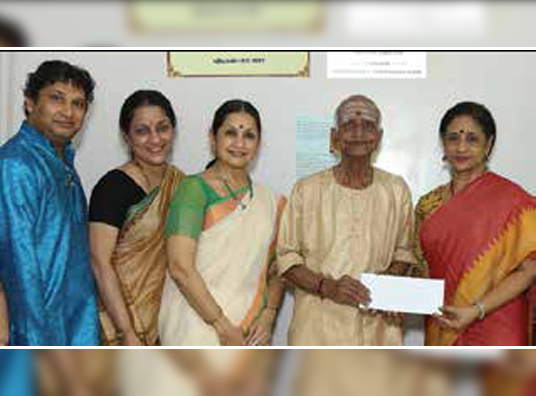
The year 2020 began as usual with festivities connected with the New Year. In Chennai, the cultural capital of India, the December- January Margazhi Mahotsavam was slowly coming to a close with most sabhas boasting of more than two months of non-stop programmes featuring thousands of artists from all over the world. February heralded the festival of Sivaratri when dancers congregated at the thousands of Siva temples to participate in dance festivals celebrating the Lord of Dance, Siva-Nataraja. March saw the commencement of the annual and board exams for students and a general lull in cultural activities. It was a bolt from the blue for the fraternity of artists world over when the deadly Corona virus struck and literally stunned people into a shocked silence and inactivity in the form of the “lockdown”. Realisation about the enormity of the situation dawned slowly with everyone trying to come to terms with the novel challenges in day to day life.
Members of the artistic fraternity were preparing themselves for the various tours abroad for performances, arangetrams, workshops and other assignments for extended periods of over five to six months. How would the lockdown affect their livelihood? The first reaction was one of shock, disbelief, and dejection, which got slowly transformed into acceptance of the current situation and drawing up of plans to deal with the crisis.
Steps were required to resurrect the largely unorganised sector of culture comprising mainly of professional and non-professional artists from various classical dance and music styles, as well as the thousands of folk artists and traditional arts & crafts persons who were rendered jobless.
The Association of Bharatanatyam Artistes of India (ABHAI) has, over the years, been playing a proactive role in artists’ welfare. This time too it soon swung into action. The organisation’s president, Roja Kannan, shares how ABHAI implemented its plans.
“We had to take some hardcore decisions on how to deal with the crisis that artists were facing because of the pandemic and how to find intermediary and immediate solutions to their day to day problems. An emergency committee meeting was convened online and thus was born the initiative called ‘Abhai—Artistes for Artistes Welfare Fund’.
An appeal for funds was framed by means of a video which was produced by Abhai, wherein all the committee members performed, and I appealed for funds at the end. The songs were carefully chosen, keeping in mind the gravity of the situation, and the need to gain strength from one another in a spirit of mutual give and take. We put together lyrics of poet Sahir Ludhianvi which speaks of equality and equanimity, verses from Ramalinga Adigalar’s Jeeva Karunyam which talks of compassion towards everything on Earth—the flora, fauna, the hungry, the poor and the sick, and finally verses from Maitreem bhajata which talks of universal peace and harmony. Each committee member recorded his/her portion from home and with some in-house editing skills we launched the appeal-video on Tamil New Year’s Day on 14 April. The video was shared through all our social media platforms, as well as the Abhai WhatsApp groups comprising nearly 3000 members, in the spirit of self reliance or ‘atmanirbhar’.
To read the full story click here : http://srutimag.blogspot.com/2020/08/abhais-artistes-for-artistes-welfare.html
Unlocking a range of talent
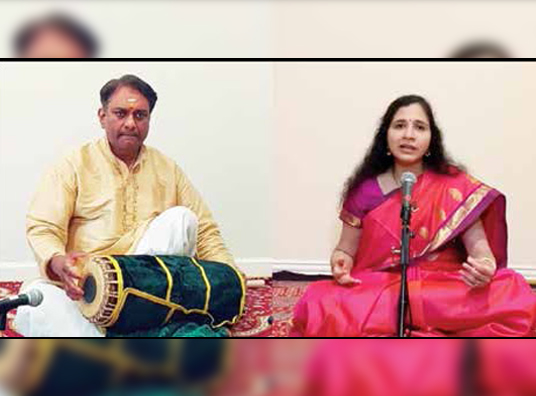
And then they
were back, though in a truncated form. The concerts started all over the place.
Narada Gana Sabha held its annual Sadguru Gnanananda Sangeet Sammelan, which is
usually scheduled in September. This time it was for four days with concerts
held in camera sans audience. The duration of each concert was one hour.
The inaugural
concert was the violin duo by A. Kanyakumari and her disciple Embar
Kannan accompanied by Mannargudi Eswaran (mridangam) and Purushothaman
(khanjira). The brisk opening with Pranamamyaham set the tone and pace.
The alapana in Todi was followed by Syama Sastry’s swarajati Rave
Himagirikumari. An intensely moving piece, the swara passages even without
the lyrics conveyed the same intensity of emotion. Another alapana in Arabhi was
the prelude to Palimpa raava delara, a rare composition of Pallavi Sesha
Iyer. The unusually formatted, racy chittaswaram, said to have been composed by
vidwan T.M. Thyagarajan, eminently suited the instrument and added pep to the short song. The main piece
was an expansive alapana in Kalyanavasantam, soaked in emotion. The guru and
the sishya played second fiddle to each other with such empathy that it was a
seamless build up to a high point and resolution. The kriti Sree Venkatesam
in Kalyanavasantam with the Guruguha mudra (attributed to Muthuswami Dikshitar
and to Ambi Dikshitar) is a beautiful
composition, regardless of whoever might be the composer. The raga seems to
have dictated the treatment for the swaraprastara which proved to be an object
lesson in sustaining the mood set by the alapana and the song. The brief and
sharp tani avartanam was followed by the enchanting Muralidhara Gopala
in Mand, and the concert concluded on a meditative note Madhava mamava deva
in Neelambari. Kanyakumari’s total identification with her instrument lets the
playing go almost on autopilot as her fingers fly over the strings. To have
trained a disciple to share the dais on an almost equal participation speaks
volumes for her as a teacher of extraordinary competence and generosity.
A rich and
ringing voice ensured instant appeal to Manimaran’s concert, from the
opening syllables of the viruttam in Nata. Swaminatha paripalaya was
crowned with an assertive swaraprastara, far from the run of the mill kind. The
rest of the concert was a welcome pack of Tamil compositions. A spirited
alapana of Suddha Saveri entirely in akaaram was followed by the Papanasam
Sivan kriti Arumuga adimaiyai kai viduthal aramalla. The pallavi which
sounds like a statement in prose, metamorphed into evocative lyrics through the
power of the music. Sound pathantaram, adherence to the sangati build up and a
clear enunciation of the lyrics breathed life into the song. Sivan followed
again with the Poorvikalyani kriti Ksheera sagara. The raga Nadanamakriya
spells poignance and when it comes at the tailend of the concert enveloping
bhakti soaked lyrics, it can be a moving experience. It did here when Manimaran
concluded with the Tevaram Pattharai panivaarkal ellaarkkum adiyen. The
judicious use of canned applause at the right moments created the aura of a
packed auditorium and enhanced the concert experience.
A plethora of
organisations have sprung up at home and abroad to provide a platform to a host
of young musicians, performing from their homes. Sa Ni Da Pa Live operates
from the US and some of the talents they have showcased are indicative of the
vast unexplored hinterland of unseen and unheard artists, who deserve to be
heard and encouraged. Sharada Karthik, who has been into music for three
decades, had the advantage of having Sriram Brahmanandam accompany her
on the mridangam (from a different venue), during lockdown and isolation.
Opening on a bright note with Marakoti sundari in Bahudari, a
composition of GNB, she took up Chintayamam in Bhairavi as the main
piece. Competent alapana and swaraprastara and rendering of the kriti testified to her maturity and
involvement in the art. A lovely tillana in Durga composed by Lalgudi Jayaraman
concluded the short and commendable mini concert. Rucha Muley launched
on Pooria
Dhanasree and Bagesree, which testified to years of training in Hindustani
music. Endowed with a voice that coursed up and down with comfort, she
presented a rich fare in the short span. Nisha Kulkarni took off into
Madhukauns and her powerful and melodious voice explored the emotional content
of
the raga.
Watching and
listening to these young set of talents, one could not but admire and
appreciate their commitment to their art and their enthusiasm and involvement.
It is a matter of conjecture whether
they would have many
performance opportunities or other avenues to pursue a career in music. But the
talent, training and practice are unmistakable. The digital platform is a great
opportunity for them to be noticed and brought to
the fore.
The descendants
of vidwan Sathur A.G. Subramaniam paid a novel tribute to their ancestor
through a Nada Nivedanam by twenty of his grand and great-grand children
rendering a rare song made famous by him and his disciples. Singing from their
respective homes in several countries and continents, they created a musical
mosaic that was posted on Facebook and YouTube. Two young girls also presented
it in dance alongside. This was conceptualised by his daughters Lalitha
Santhanam and Bhuvaneswari Rajagopalan, popularly known as Sathur Sisters.
Taught and monitored by them, this gem of a song, Sree Jagadamba kadamba
vananta vasini Meenakshi maye, came through with the purity of a venerated
pathantaram and the sense of devotion and dedication to their forebear and the
Goddess of Madurai. Inheritance of an art is a treasure that can only augment
with time. Not many families realise the value of this and the pursuit of music
as career or a serious hobby was not an option until a few decades ago. The younger
generation migrating to alien shores for career prospects often lost touch with
the art or maintained a casual interest; and the second generation lost the
context altogether. The new millenium has been witness to a resurgence in the
arts at home and abroad and the gen next has taken to it with a sense of
belonging and pride in their heritage. This family is a telling example of this
phenomenon where the ancestor was more a legend whom they had never met. And
they took to his art on their own impulse.
Strung in the
appealing ragamalika of Chenchuritti, Punnagavarali and Nadanamakriya, the song
Sree Jagadamba has an unusual form and gait with evocative namavali.
While the song is given as a single raga composition in some texts, Sathur’s
version was in ragamalika. The composer is variously known as Ramachandra Bawa,
Ramachandra Bhave and Ramachandra Kavi. Musicologist Premeela Gurumurthy
informs that there was a kathakar called Ramachandra Morgaonkar Buwa, a
contemporary of Serfoji, in Tanjavur. It seems probable that he might have been
the composer of this song. Scholar and musicologist, B.M. Sundaram informs that
the composer’s descendants are still living in his old house in Tanjavur. He
also says that the kathakars composed and sang several songs as illustrations
for their story, which were known as “kathai uruppadis”. This song which is in
Manipravalam of Sanskrit, Telugu, and Marathi, and does not adhere to the kriti
or keertana format, is a movement in emotive appeal. This gem cannot be a loner
from a gifted creator, there must be more. One can only wish that someone would
unearth them and add them to the inexhaustible storehouse of compositions that
form the body of Carnatic music.
A forward from a
friend brought a picture in a quadruple frame. A girl was dancing in one while
a girl was doing nattuvangam in the next. The third frame showed a girl singing
and the fourth was that of a girl accompanying on the violin. I did a double
take and found that it was the same girl in all the four! It was the multi-talented, versatile Parur
M.S. Ananthasree of the famed Parur clan of musicians. Granddaughter
of Parur M.S. Anantharaman and daughter
of Parur M.A. Sundareswaran, both violin vidwans, Ananthasree has trained in
violin, vocal music, and Bharatanatyam. She has also proved her mettle in
composing music for dance. Another instance of the younger generation pursuing
the art of the family forward.
Then there was
the deluge of 345 artists presented in 245 concerts spread over 20 days.This
was the unique Viswa Veena Mahayagyam organised by Narada Gana Sabha and
The Bharata Ilango Foundation for Art and Culture (BIFAC), curated by veena vidwan Kannan Balakrishnan
and hosted by Kalakendra, the crusader for the performing arts on the digital
platform. A festival of this magnitude calls for separate coverage.
Music is sacred,
music is spiritual, music is bhakti, music is meditation, music is a tapas....
Wait a minute, music is fun too! This generation is aware of it and enjoys and
imparts the fun. The seven-minute short film by the cousins Anantha R.
Krishnan and musician Abhishek Raghuram, produced by Madrasana is a
quirky and unique treat in rhythm play—and play it is for the virtuoso pair.
They call it ‘super heavy, ultra magic’. Both are grandsons of the mridangam
maestro Palghat Raghu and are his disciples, one a left hander and the other
right.They play on two mridangams
facing each other within arm’s
length and indulge in top speed variations on the first syllables ta dhi tom
nam of the mridangam lesson and build on them. With cameras on either side
and from the top, the rhythm goes on with the young men playing on one
another’s valantalai (right side) and toppi (left side), giving hi fives,
snapping of fingers and beats on the lap. On the beat and syncopated, the
syllables go nonstop with the precision of a metronome. Inherited and perfected
with passion and perseverance, laya runs in their veins and reigns supreme in
this exhilarating manifestation.
The lockdown has
also provided an excellent opportunity to well known organisations to share
good programmes from their archives. Natyarangam, the dance wing of the Narada
Gana Sabha, started webcast of two of its thematic festivals held in the last
couple of years. The first was Devi Bharatham, where the aspects
of Devi were presented under the titles Janani, Harini, Paalini, Vani and
Poorani by Divya Shivasundar, Meera Sreenarayanan, Pavithra Bhat, Praveen Kumar
and Narthaki Nataraj, respectively. The performances, which were posted one per
weekend, gave enough time for viewers around the globe to catch it and not get
surfeited. This was followed by the dances of the Chithra Bharatham festival
where the paintings of artists like Thota Tharani, Keshav, Ramesh Gorjala, Ravi
Varma and S. Rajam were presented by Rama Vaidyanathan, Lakshmi Ramaswamy, K.P.
Rakesh, Lavanya Ananth and Navia Natarajan respectively. These two festivals
saw the blossoming of the talents with new ideas in concept and execution. Over
the years, Natyarangam’s annual
thematic festivals (featuring an
insightful talk followed by the dance) have achieved a twofold purpose—the
progress and maturity of the individual artists and the advancement of the art
in a dynamic progression.
Sruti has been featuring very informative and
interesting lecdems from its archives on its YouTube channel. One such was ‘Ragas created by Tyagaraja’ presented by versatile musician-scholar
Sriram Parasuram, during the Lecdem Mela on Tyagaraja, organised by
Sruti and the Music Forum in 2017. He illustrated what a master craftsman
Tyagaraja was in his creation of ragas and in being the first to explore some
of the melakarta ragas like Keeravani. He classified Tyagaraja’s methodology
into four—namely varjya (dropping of notes), vakra (changing the linear order
of notes), anga (putting together parts of different scales) and janya (born of
a parent scale). It came as a surprise when he mentioned that there were more
than eighty ragas that Tyagaraja had composed. It was a greater surprise to be
told that the familiar and oft repeated ragas like Hamsanadam were his
creations as were Chandrajyoti and Jaganmohini. Sriram could have gone on for
hours and the audience willing to journey with him all the way wandering around
the glorious garden of ragas. Perhaps he should plan on a series of talks on
the subject, which would be a veritable archive for the musician and the
student as well as a fountain which could quench the thirst of the rasika.
The lockdown
lifted, my serenade—the nightingale in my neighbourhood, seems to have flown
away and how
I miss the music!
SUJATHA
VIJAYARAGHAVAN
(Writer, musician and dance scholar)
Hamsadhwani donates for artistes/stage technicians benefit fund
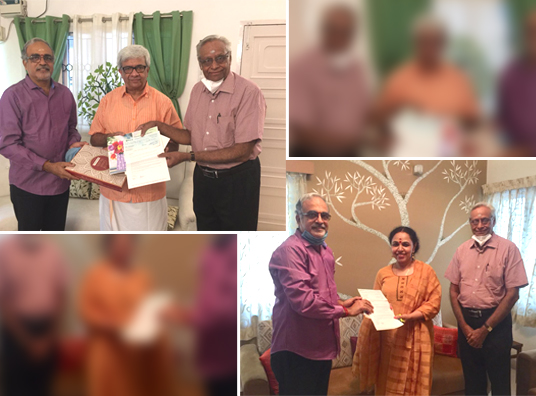
Hamsadhwani , Chennai has always
supported social causes in its three decades journey as a responsible cultural
institution.Our founder R.Ramachandran has in the past helped raise resources
for earthquake, floods and Tsunami affected people and in keeping
with his ideals we respond to this difficult situation for artistes with
assistance. We are aware of the economic hardship that
artistes/technicians are facing due to the disruption in cultural
programmes .
We dedicated our 30 th Anniversary
celebrations to all those who are in the forefront fighting the Pandemic and
helping save lives .On this occasion, we conveyed our gratitude to the artistes
fraternity and felt it would be appropriate to make a contribution towards
artistes benefit fund .
Accordingly Hamsadhwani presented a
cheque for Rs Fifty thousand to Global Carnatic Musicians
Association and Rupees Twenty Five Thousand to the Tamil Stage Drama Producers
Association and Shri Ramnath Mani,President, Hamsadhwani and
R.Sundar, Secretary of Hamsadhwani handed over the amounts
personally to Sangita Kalanidhi Smt Sudha Ragunathan, President ,
GCMA & Shri Y.GEE.Mahendra , President of Tamil Stage Drama
Producers Association on 10 th October, 2020.
Hamsadhwani communicated to GCMA and
the Tamil Stage Drama Producers Association to identify the
artistes/technicians who need help and support with financial
assistance.
Both Smt Sudha Ragunathan and Shri Y.Gee.Mahendra lauded this touching gesture from Hamsadhwani Team and hoped this would inspire others. R.Sundar, Secretary hoped that other cultural organizations would come forward to help the indigent artistes in these Pandemic times. He expressed his wish that cultural events should resume only when things become safe and conducive for gatherings.
Demystifying Tamil texts
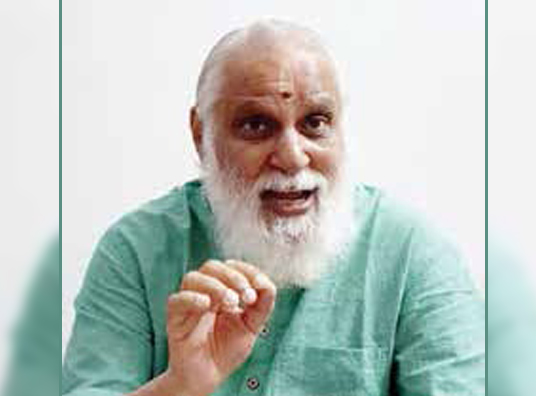
Appreciation of Tamil texts, a novice
friendly ten-hour web series by the erudite professor S. Raghuraman, helped to
demystify and reintroduce the beauty and relevance of iconic ancient Tamil
texts. A thorough overview of 2500 years of Tamil legacy was split into the
ages such as Sangam, Epic, Ethics, Medieval or Bhakti and Contemporary age
until Subramania Bharati.
A welcome burst of positivity during
lockdown led us down the proverbial rabbit hole, organised by Upasana Arts and
supported by Arts Council UK. Appreciation of Tamil texts is a part of
Upasana’s larger project Ojas, which takes pride in making cultural
heritage more accessible along with a focus on reconnecting with
your roots through holistic education and an enhanced understanding of
Bharatanatyam practice and performance.
With the hope of
spreading positivity to as many as possible, we reached out to the bustling
dance fraternity including the networks of ABHAI and Prayathnam and within two
days received more than 250 registrations from cities in India, such as
Madurai, Coimbatore, Kolkata, Chennai, Mumbai and Rajkot, and from countries
across the globe from the US, UK, Europe, Singapore and Australia. As one can
imagine, we had to overcome many initial technical hiccups from malfunctioning
laptops to disconnected time zones, until we finally decided that all the
recorded sessions would be rigorously edited and uploaded in Upasana Arts’
YouTube channel, to be disseminated to eager rasikas. To accommodate visual
learners and support the nuanced teaching style, detailed notes were collated
and circulated with questions being regularly clarified. Jayanthi Sivakumar, a
participant from the UK observes, “It’s been a pleasure to hear the scholar S.
Raghuraman share his expertise on ancient Tamil literature and its relation to
dance. His explanation was clear, simple and easy to understand. All thanks to
him for bridging the gap and reinstating the pride in our heritage.”
Feedback clearly
suggested that given the complexity of the content, it was beneficial that
recordings be available to replay multiple times, cross refer and loop back to
different sessions. Participants who were keen to have live virtual face time
with sir were invited across two different days to accommodate
international time zones.
The professor’s
innate style managed to simplify and deconstruct the most complicated content
with beautifully illustrative examples and relatable citations across various
artistic disciplines like music, dance, drama, cinema, and literature along
with detailed historical, cultural, social, philosophical and psychological
contexts. He patiently covered concepts with his wit as he often repeated
himself with the knowing smile of an experienced teacher. Referring to his
classes, vidushi S. Sowmya recounts, “Asking Sir a doubt was like asking a
veteran to teach Sa Pa Sa!” His own personal academic rigour and
eclectic interests helped frame our learning within a wider context,
establishing and reiterating that Tamil was not only an ancient and
comprehensive language system with technical rigour and maturity in all
linguistic aspects like grammar, phonetics, prosody and poetics, but also that
Tamil texts were a true fount of knowledge in subjects like literature,
politics, geography, commerce, arts, science, sociology and psychology. An
understanding of the Sangam texts such as Tolkappiam, Meipattiyal and Silappadikaram, reflects
not only Tamil’s antiquity, butalso their relevance to this day.
It is impressive
that a text like Tolkappiam from 7th century BC is so
scientific, methodical and timeless that its syntax and grammar rules are
followed to this day in linguistics. Tolkappiam is not only
systematic and comprehensive but also unique in its insightful understanding.
It expounds that every Sangam poem is based on the speaker, the listener, and
the context, each leading to a nuanced narration and consequent reaction.
It is interesting
that for a book on grammar, it even includes a seminal chapter on human
emotions and rasa theory, Meipattiyal. Sringaram alone is detailed
as an independent chapter with four types and is further segmented as
‘kalaviyal’—love before marriage, and ‘karpial’—love after marriage, with each
having a possibility of twelve stages.
The depth of Sangam
texts reflects how arts, ideology and society, were far beyond the reaches of
present understanding. For instance, the Koothanool by
Sattanar (Tolkappiar’s contemporary) uniquely defines emotions based on the
gunas—rajas, tamas and satvik. The Panchamarabu from the 5th
century CE speaks of: aan kai: male hand (gestures); penn kai: female hand;
pothu kai: neutral hand; and alli kai: eunuch hand.
Literatures
like Silappadikaram are classic ethnographic records of Tamil
Nadu, a window into the wider socio-political-economic context of the
first century, along with its flora and fauna. Silappadikaram’s third chapter
of Pugar canto, Arangetru Kathai, and Achiar
Kuravai from Madurai canto, are seminal texts in the
traditional Dravidian dance and music system respectively, and to
this day inspire engagement, research and study.
An interesting
session on music in Silappadikaram brought together the
husband-wife expert duo of Vanathi and S. Raghuraman in exploring vidwan S.
Ramanathan’s research. Additionally, the dancers— Anjana Anand shared her
firsthand experience of translating the Silappadikaram, and
Sreelatha Vinod shared her experience of working with Sir as mentor to
perform Silappadikaram for Natyarangam’s Kavya Bharatham
festival in 2003 at Narada Gana Sabha in Chennai.
Curious about
legacy and heritage, even as early as 5th century CE, the bhakti movement
established autonomous research institutions called ‘ghatika’ in Kanchipuram
with the primary purpose of collating past literature and publishing a
commentary to make it accessible. Their rigorous, deep-rooted and advanced
research methodology led to the discovery, collection and codification of
Sangam texts and a commentary was written for Tolkappiam and Silappadikaram after
1000 years. This is an artistic legacy to be acknowledged and be proud of.
This project
undertaken by Upasana Arts brought together a discerning group and a benevolent
teacher to revel in the pure joy of learning.
DEEPA GANESH
(Bharatanatyam
dancer, teacher and Artistic
Director of Upasana Arts)
Masterclass with TM Krishna

Nurturing Fearless and Serious Engagement with Karnatik Music
“I
want you to stop when you are dead with the ideas of a pattern,” TM Krishna
reminds his students. As the students sing kalpanaswaram for Deva
Deva Kalayamithe, Krishna puts down hurdles in their paths. “That is
banned.. you can’t sing that.” Some of them toy with new phrases, while the
others stumble over a note. He encourages the latter, “It is only when you sing
something wrong can you twist it and discover something.” The
intensity and the gay abandon of this musical improv makes an otherwise
high-spirited participants of the 12-days masterclass dumbstruck. The intensive
online module on Carnatic music offered by TM Krishna in two batches in August
2020, not only stressed on his radical ideas on manodharma, but
also explored the politics and aesthetics of the art form.
Past and present merged seamlessly in these sessions. Along
with Krishna, we went centuries back in time to study the evolution of
the kirtana as a dominating compositional structure, the
journey of the veena, violin and nagaswaram into the Carnatic
fold, and the emergence of bhakti as a favored literary theme in the Carnatic
canon. We looked at historical figures like Subbarama Dikshitar, the man behind
the iconic work, Sangita Sampradaya Pradarsini (SSP), and attempted to place
their creative interventions in their historical specificity. A major portion of
the work included in the SSP is that of Muthuswami Dikshitar. “Any renowned
scholar and artist like him would have had to negotiate through multiple
contexts. How he negotiated with this illustrious lineage symbolises the
conflicts we have to deal with as artists in the 21st century; we are
constantly trying to reconcile what we have learnt vs what we do to evolve this
art form. He was also trying to make sense of things and he did it in his own
way,” observes G Ravi Kiran, student of TM Krishna who anchored this session
with him.
Some of the participants were so fired up after this
session that they pored over SSP to sing new kirtanas after
the session ended, says Anand Murthy, a veena and vocal music student
from Gurgaon. It gave him a huge conviction in what he was learning. “Another
striking thing about a few Carnatic music performers is that they can be pretty
secretive; they do not readily divulge their approach to explore a raga or to
develop an idea from a kirtana or explore tanam. And, TMK
literally gave it to us on a silver platter. I found the generosity of spirit
quite disarming. I would make notes at the end of each class. There were ready
references on how to approach a particular raga. These are clearly core
processes that I should follow in my ability to weave a swarakalpana.”
T Brinda’s rendition of a Sringara laden
padam contrasted with MS Subbulakshmi’s voice dripping
with bhakti, the session on gender contextualised the female
musicians’ aesthetic negotiations in their respective socio-cultural
backgrounds. Listening to these women of yesteryears and hearing their stories
were inspiring, says Vidhya Raghavan, another student of Krishna. “They look so
unattainable when you hear their music. But, when we humanise them and look at
them as real people, you realise the struggles they faced. They were feminists
in their own right.”
Patriarchal mindsets ruled these concert spaces,
Vidhya and Bhargavi Venkatram, who anchored the session on gender with Krishna,
echoed. The female artist must take care to follow dress codes, body
language and a socially acceptable personal life to be welcomed into the fold,
apart from being a good singer. These disclosures led to a vibrant discussion
in the masterclass that overshot its time way past the expected limits.
Participants were a vibrant lot consisting of a global
diaspora from different fields bonded by their love for the form. The chat box
always buzzed with messages. Krishna had to juggle his thoughts and the cascade
of questions that would throw open a new stream of conversation altogether. The
lively audience interaction led to some fascinating finds; like the music of a
Carnatic musician who is a trans-person. “The 12-days opened up the immense
problems of hierarchy and patriarchy that exist in this field. I personally
will not be able to listen to the music of the artist, whose politics I
actively disagree with the art cannot be separated from the artist. As
connoisseurs, it is our responsibility to look at both sides,” says Anusha
Dhasarathy, a consulting professional based in Chicago.
Separating the art from the artist has been a tightrope
walk for many. Talking about his favourite musicians endorsing religious
fascism, Rahul Gandhi, a physician in New Zealand, says: "I feel
conflicted on those occasions because these are artists I have admired for
their astonishing musical prowess; they are often epitomes of excellence in
performance."
Power hierarchy existed clearly
in the way the concert format is structured, says Anand reflecting on the main
artist session. “If we stop seeing the ghatam player as an upapakkavadyam and
instead as an equal contributor, what different possibilities open up? These
questions come from a deep interest. That’s how the art form lives, by
examining the possibilities of sound. Otherwise, it is dead.” There were no
conclusions being reached. "Through
these masterclasses, the point was not to provide black and white answers for
anyone, but to burn down what we knew, and build a framework around which to
address these issues for ourselves more robustly," says Rahul.
The idea for a masterclass in Carnatic music arose from
the students themselves. Krishna and his students worked quite intensively, by
having at least three rounds of one-on-one video calls and general sittings,
before each session. And, from the very inception of the idea, the musician was
clear that he will address both the aesthetic and the socio-political side of
Carnatic music. That is the only way forward for conversations on his art
practice, he says. “My politics comes from my art. The two cannot be
disassociated for me. We need to have more conversations that do not have these
boundaries. In India unfortunately, aesthetics is either treated in an esoteric
fashion or just put down to taste and preference. We largely see art as a
producer of emotional experiences and the socio-political as its scaffolding.
We need to understand them as intertwined beings and engage with both realities
with equal intensity.”
Parshathy J Nath
The author is a writer, theatre
practitioner and a Carnatic music trainee
Pushkala Gopal selected for the Member of British Empire

Bharatanatyam and Carnatic music exponent Pushkala Gopal has
been selected for the Member of British Empire (MBE) in the dance category
announced in the Queen’s Birthday Honours list 2020. The award, Member of the
British Empire, is given for ‘outstanding and exemplary service to the
community’. Pushkala is also the recipient of Viswakala Bharati award from
Bharat Kalachar, Chennai. She is one of the seniormost disciples of The
Dhananjayans.
PKM 100
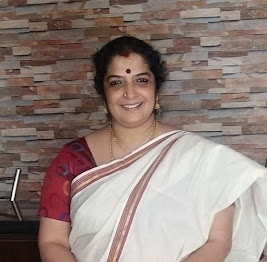
Puducode Krishnamurthy (1923-1985) was a popular musician from Kerala and a direct disciple of Palghat Rama Bhagavatar. He joined the Chembai Memorial Music College, Palakkad, in 1958 as a professor of music and later transferred to Swati Tirunal College of Music, Tiruvananthapuram, in 1970. In 1976 he became the principal of Chembai Memorial Music College and retired in 1978. A vidwan par excellence, he had a large fan following. Blessed with a resonating voice, with authentic pathantaram of kritis of various vaggeyakaras, he was respected by the musicians and was a regular performer in the prestigious Navaratri Mandapam, where he popularised many kritis of Swati Tirunal. But the fact that he was a versatile composer too is not known to the public.
Baby Sreeram is a senior musician, guru, composer and disciple of Ananthalakshmi Venkatraman of Tiruvananthapuram and Sangita Kalanidhi T.M.Thyagarajan. Baby Sreeram got the handwritten book containing the songs from a family friend of the composer, has curated this project to popularise 100 compositions of Puducode Krishnamurthy within a year. Puducode Krishnamurthy has more than 200 compositions to his credit. The songs are on various deities like Devi, Guruvayoorappan, Ganapathy, Vishnu, Hanuman, Narasimhar of Sholingar, Perumal, written in Malayalam, Tamil, Sanskrit and Manipravalm. He has composed songs on Arupadai Veedu and also on the navagrahas.
To read the full article - click here http://srutimag.blogspot.com/2021/11/pkm-100.html
Sundara Amudha Ganam
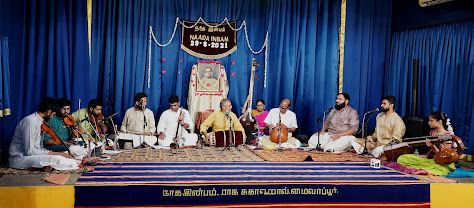
Sundaravalli Ammal was a simple homemaker who was not formally trained in music or literature. Because of divine blessings, she composed songs on the deities she visited and wrote them in a notebook. Sundaravalli Ammal was born in 1906 in Kuzhumani village in the Tiruchirapally district. After her marriage to K.Rajam Iyengar, a school teacher at the age of fourteen, they lived in Srivilliputtur, Vellore, Srirangam, Nellore, Madurai and Coimbatore. She managed her family of six children with the income of her husband as a school teacher. Besides her household chores, she found time and inspiration to pen her outpourings which came to her spontaneously only because of her divinity and simplicity. The songs are in Tamil praise the glory of the various Gods and are written with utmost simplicity. The songs were written in a notebook, which her grandchildren have since located, and they decided to publish and popularise them.
In some songs, she has indicated the name of the raga, but most of them do not contain any indication of any specific raga or tala. She breathed her last in 1980. The compositions of Sundaravalli Ammal deserve our patronage and publicity.
The family members of the late composer published the book titled Kaanaadha Kovilkal - Kelaadha Geethankal in the year 1991, containing some of her compositions. As a sequel to that, another ten songs have been tuned and notated by mridanga vidwan Arun Prakash in the most appealing ragas. The family released the book on 29 August 2021, handing over the first copy to celebrated musician P.Unnikrishnan. The book contains the sahithyam in Tamil and English and notations in English to learn these compositions and present them in concerts. After the book release, the songs were presented to a live audience with a team of musicians led by Arun Prakash.
To read the full article - Click Here http://srutimag.blogspot.com/2021/11/sundara-amutha-ganam.html
SBKK’s ‘Ram’ continues to enthral generations
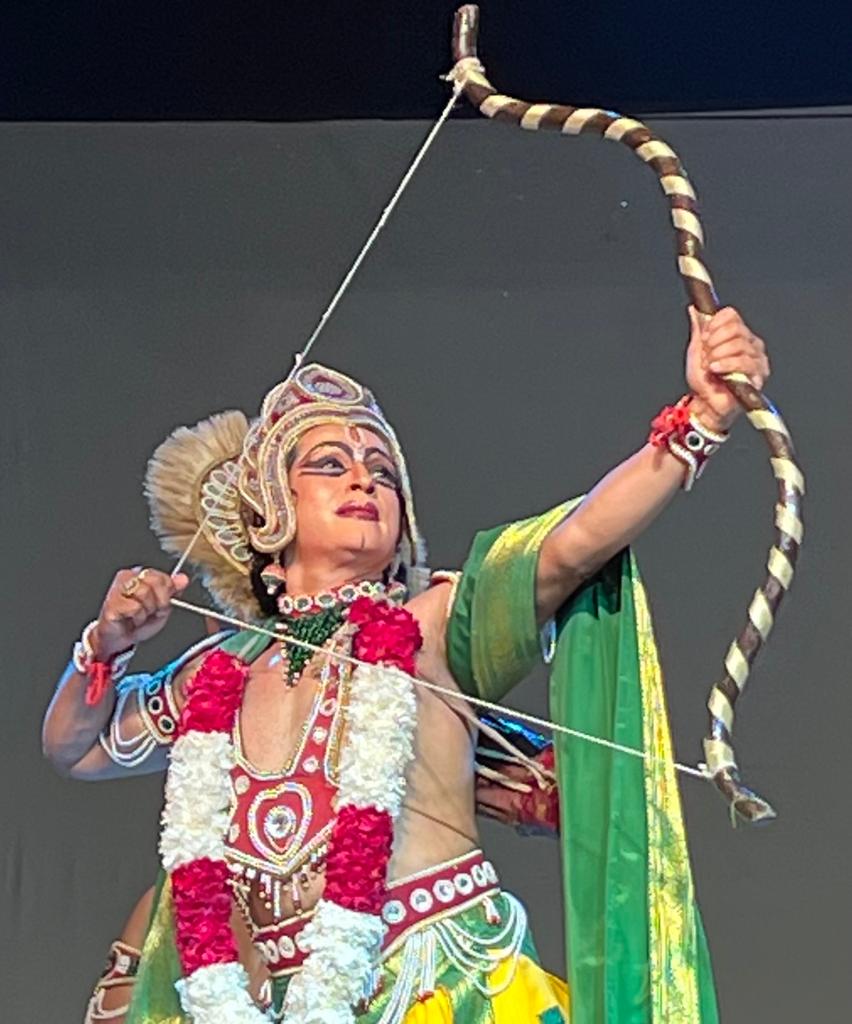
Delhi’s Ramleela, now in its 65th consecutive year, played to packed audiences in the capital through the Dussehra month of October. Originally enacted with a live orchestra in Delhi’s Feroz Shah Kotla grounds, Shriram Bharatiya Kala Kendra’s iconic production, now termed simply Ram, assumed a legendary hue. Creditably, it has been witnessed by most of India’s Prime Ministers.
Much has changed in the dance-drama over the decades, but much has also remained the same. The original script derived from Goswami Tulsidas’s Ramayan was rewritten in the mid-1990s in ‘khari boli’ to cater to a modern Delhi audience who could not fully comprehend the Awadhi dialect. With this came the necessity to recompose the music, to fit the new sahitya. The music of the over two-hour production had to be painstakingly re-recorded.
This was not so easy a task; the composing of music for a dance-drama production, where due consideration had to be given to the lyrics and movements, was something that many professional musicians 40 years ago had not experienced. Nor were they ready to take on a project that involved so much time and tweaking of the music to fit in with the movements. Thinking of appropriate music while the monkeys scampered or the golden deer enticed Sita in the forest, involved thinking out-of-the-box for a classical musician. Another concern was tuning music to a changed script; some thought it was sacrilegious to tamper with the original holy words of Tulsidas. Apparently, many senior classical musicians approached for the task refused.
The final recording saw simultaneous recording in three studios, more than 400 pieces of music strung together, during a non-stop period of more than three months! Truly a herculean task -- sarodist Biswajit Roy Choudhury, who composed the music recalls, “I barely ever had lunch during those three months!” About 120 musicians were roped in; an added concern was working with musicians who had studio recording experience and could also give uninterrupted time for days to record. The final new soundtrack recording came together in 1999. It involved the combined effort of several musicians, including vocalist Shanti Sharma and the recording expert – the late Jwala Prasad (a part of dancer Uma Sharma’s team). The vocalists included the late Shanti Sharma, Jitender from the Kathak Kendra and Indu Prakash.
To read the full article - http://srutimag.blogspot.com/2022/02/sbkks-ram-continues-to-enthral.html
Kapila Vatsyayan - A Tribute

Dr. Kapila Vatsyayan was one of the most distinguished personalities and unparalleled scholars of our times. Of course, much has been written and published about her scholarship and wisdom; nevertheless I take the liberty of sharing a few thoughts about her since I have known her for over six decades.
I first met Kapila ji while she was still an under-secretary to the Government of India, Ministry of Culture in New Delhi in 1958-59. This was the time when I was awarded that prestigious Government of India scholarship by the Ministry of Culture, New Delhi. I was 14 years old then. She had signed in the correspondence and the certificate. I was later given to understand that my scholarship award was challenged. The reason was that I was pursuing my schooling while training to become a Bharatanatyam artist. It was mandated that only students from traditional families were eligible for such scholarships. However, my scholarship was upheld and I was awarded the same as a special case. Kapila ji continued to keep in touch with me even after my marriage in 1965. She used to visit us in Chennai and has also stayed with us. She made it a point to get me butter (in the mud-pot) prasadam from Dwaraka whenever she went to the temple. She was a spiritual person and we have travelled to Kancheepuram to pay obeisance at the Kanchi Kamakoti Peetham.
To read the full article - http://srutimag.blogspot.com/2022/02/kapila-vatsyayan-tribute.html
Tribute - Sivasakthi Sivanesan
Sivasakthi Sivanesan, well known Carnatic vocalist, vainika, and music teacher with the Bharatiya Vidya Bhavan in London, passed away on 31 October 2021.
Sivasakthi was born in Jaffna, in northern Sri Lanka, on 21 February 1957, in a musical family. Her father was her guide and mentor, and her training in music and dance began at the tender age of five. The renowned Yazhpanam N. Veeramani Iyer -- a composer, choreographer and dancer -- was her first guru. She performed her arangetram in Jaffna when she was thirteen, in the presence of S. Balachander, the chief guest. She continued her musical training from stalwarts like Chittoor Subramania Pillai (vocal) and Kalyanakrishna Bhagavatar (veena) at the Ramanathan Academy of Fine Arts and graduated with a Sangeetha Ratnam diploma when she was just fifteen. Sivasakthi was proficient in Carnatic vocal music, the veena and Bharatanatyam.
To pursue advanced training in music, Sivasakthi left Jaffna for Chennai in 1972 and enrolled at the Carnatic Music College. She was fortunate to learn from eminent musicians like D.K. Jayaraman, Prof. S. Ramanathan, R. Vedavalli, K.V. Narayanaswamy, T.M. Tyagarajan, B. Rajam Iyer, Sandhyavandanam Srinivasarao and Tiruppamburam Shanmugasundaram in Chennai. She also took special training in nattuvangam from natyacharya Adyar K. Lakshman in Chennai.
To read the full article - http://srutimag.blogspot.com/2022/02/tribute-sivasakthi-sivanesan.html
Award for Vidushi Jayanthi Kumaresh
Sri Rama Lalitha Kala Mandira honoured Vidushi Dr. Jayanthi Kumaresh with ‘Sangeetha Vedantha Dhurina’ which is instituted in the name of its visionary founder G Vedantha Iyengar on on 8 May 2022 at The Bangalore Gayana Samaja. The award carries prize money of 1 Lakh, a Silver medal, and a Citation. His Holiness Sri Sri Jeeyar of Yathiraj Mutt, Melkote blessed and presented the title.
Explorations: a journey of 25 years in Odissi
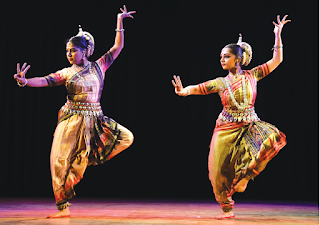
Ileana Citaristi’s Art Vision closed their year-long silver jubilee celebrations of performances, webinars and discussions with a grand presentation of some of the landmark items choreographed by the distinguished dancer and performed by the repertory members of the organisation on two consecutive evenings on 12 and 13 January 2022, at Rabindra Mandap in Bhubaneswar.
The first evening of this concluding event entitled “Explorations: a journey of 25 years in Odissi” showcased a series of rhythmic and expressional items and was accompanied by a live orchestra. The event opened with a fine duet Mangalacharan in honour of the tandava aspect of ‘Kapalika Siva’ based on a music composition of Prafulla Kar. This particular item has a special significance as it was the first composition for Odissi dance by Kar in 1985 and has been revived for this occasion.
Click here to read the full report http://srutimag.blogspot.com/2022/04/explorations-journey-of-25-years-in.html
Visakha Music Academy's 52nd Annual Music Festival
 (1).jpg)
The Visakha Music Academy was formed in 1969 at Visakhapatnam by a group of rasikas, to promote and propagate Carnatic music in the city.
The 52nd edition of Visakha Music Academy’s music festival happened during the last week of November 2021. They successfully hosted live concerts everyday, while maintaining proper safety procedures to prevent the spread of the virus. Unlike other live concerts that mostly had a time limit of two hours, these concerts extended for three hours and had a better turnout of rasikas than the organizers had expected. Artists such as Sikkil Mala Chandrasekhar and Gayathri Venkatraghavan enthralled the audience with their vidwat. The array of concerts included an equal number of instrumental, as well as vocal concerts, providing a variety of music for the audience.
to read the full article click here http://srutimag.blogspot.com/2022/04/visakha-music-academys-52nd-annual.html
Indo-French Reflection Group celebrates 30 years

The Indo-French Reflection Group, whose official name is “Le Groupe de Réflexion Franco Indien” (GRFI) is not only familiar among Parisians but also with frequent travellers to the city. GRFI reflects the immigrant, multicultural nature of Paris. The musicians mostly amateurs, some near amateurs and a few professionals come from Afghanistan, Argentina, Bangladesh, France, India, Sri Lanka and Germany.
Thirty years is a significant milestone, and for the past three decades, GRFI has been showcasing Indian culture on French soil with monthly conferences on themes like ancient and contemporary history, arts and literature, religion and philosophy and science and technology. An annual music event is organised as a lecture demonstration.
To read the full article click here http://srutimag.blogspot.com/2022/04/indo-french-reflection-group-celebrates.html
Book Review - A GRAMMAR OF DANCE
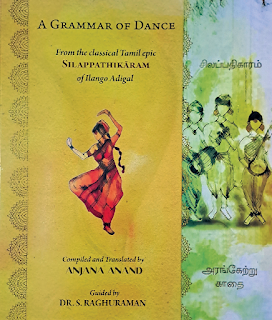
The epic Silappadikaram and its unequalled position in classical Tamil literature perhaps needs little introduction. Anjana Anand’s effort to examine the Arangetra Kaadhai—a seminal chapter that addresses dance in particular and extracts a translation with guidance under the eminence of Prof. S. Raghuraman, is a work that will prove infinitely useful particularly to dancers. They have long awaited such a helpful guide to the classical language in the epic, and the work and effort must be commended. Anjana’s own training and exposure to the world of dance brings in an angle of focus and clarity that is important and needs to be acknowledged. While the epic has seen multiple translations over the last century and more, the works have been summary extractions of the chapters and storyline that follow a descriptive form intended for general audiences. This work sets itself apart. Anjana’s presentation showcases a detailed meaning stream aimed at non-Tamil speakers (or scholars) with the most important aspect of a ‘word to word’ meaning and ‘phrasal’ transliterations in the Roman script with summaries that follow. In the coming decades and more, this work will benefit research scholars and the student fraternity from undergraduate to doctoral levels. Across the passage of time, translation attempts of epics often cross-refer to commentaries by erudite scholars that provide invaluable perspectives. These clarities add context and content understanding that illuminate readers with insights and clarity that carry meaningful learnings most often related to general life and the social fabric of the bygone ages. In this work, Anjana has included the insights of perhaps the earliest known commentators – Arumpada Uraiasiriyar (10th century) and Adiyarkkunallar (12th century).
To read the full article - http://srutimag.blogspot.com/2022/08/bookshelf.html
An Anthem for Mylapore
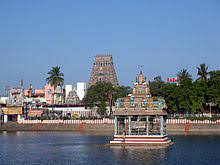
August is the time when several events are organised to celebrate Madras Day, Madras Week and even Madras Month. Madras Day is celebrated on 22 August every year. The idea of a Madras Day was first suggested by Chennai-based journalist Vincent D’Souza, the Editor of Mylapore Times and Kutcheri Buzz, to the late S. Muthiah, historian, author of books on Madras/Chennai and former editor of Madras Musings. This happened at a meeting of the Chennai Heritage in 2004. Madras Day celebrations have been held every year since then. Vincent D’ Souza was also the catalyst in launching the Mylapore Festival which has become very popular over the years as the Sundaram Finance Mylapore Festival. It is a cultural feast held in January every year in Mylapore -- one of Chennai’s oldest neighbourhoods. It is interesting to note that an anthem for the Mylapore neighbourhood was created as a part of the Sound & Light show that premiered at the Sundaram Finance Mylapore Festival in 2009. It was played every evening during the festival. Rendered by several artists and children, the anthem video can be viewed on YouTube.
To read the full report & view the video http://srutimag.blogspot.com/2022/08/an-anthem-for-mylapore.html
Hemavathi – Remembering Parassala Ponnammal
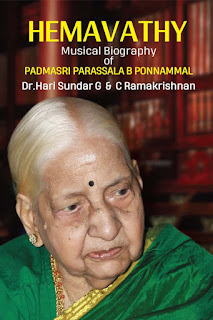
Hemavathi -- a musical biography of Parassala B. Ponnammal -- jointly authored by G. Harisundar and C. Ramakrishnan -- was released at a well-attended function at Ragasudha Hall, Mylapore, Chennai on 22 April 2022. Hemavathi is a rough translation into Sanskrit of Ponnammal -- the celebrated vidushi from Kerala -- who was born on 29 Nov 1924 at Parassala, south of Tiruvananthapuram. She lived a simple life, soaked in chaste Carnatic music, till June 2021 when she shed her mortal coils.
The event in Chennai was jointly organised by the department of music, Kannur University, Nada Inbam, Chennai and Hemavathi Music Chamber, Tiruvananthapuram.
Click here to read the full report
http://srutimag.blogspot.com/2022/07/hemavathi-remembering-parassala.html
A Janardhanan 80 – A monumental innings
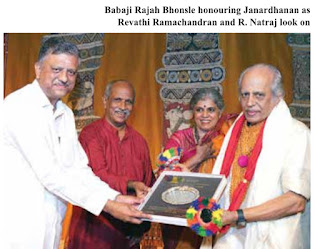
Kalakshetra Foundation celebrated the ‘satabhishekam’ -- 80th birthday of their Professor Emeritus, A. Janardhanan, on 23 April 2022 at the Bharata Kalakshetra auditorium in Chennai. It was a glowing tribute to a man of great stature who has been the driving force of the institution, having been associated with it for an extraordinary 65 years and still counting. In an era of constant change and shifts of allegiance propelled by monetary or other considerations, this has indeed been a monumental inning by one person in one institution.
The programme commenced with a brief introduction of the events to unfold, followed by a prayer song by students. A video was screened tracing Janardhanan’s journey at Kalakshetra -- from his arrival at a tender age to his blossoming into a consummate artist, crossing various landmarks, his achievements, till his attaining the status that he has come to occupy in the minds and hearts of his students and contemporaries. There were tributes by Pushpa teacher who taught him, and Preetha Reddy recounting her days at Kalakshetra and her association with the veteran artist. Kalakshetra Chairman, S. Ramadorai, variously touched upon Prof. A. Janardhanan’s life, contribution and dedication to his alma mater.
To read the full article - http://srutimag.blogspot.com/2022/07/a-janardhanan-80-monumental-innings.html
Impressive tributes to Rabindranath Tagore - Jyotirgamaya
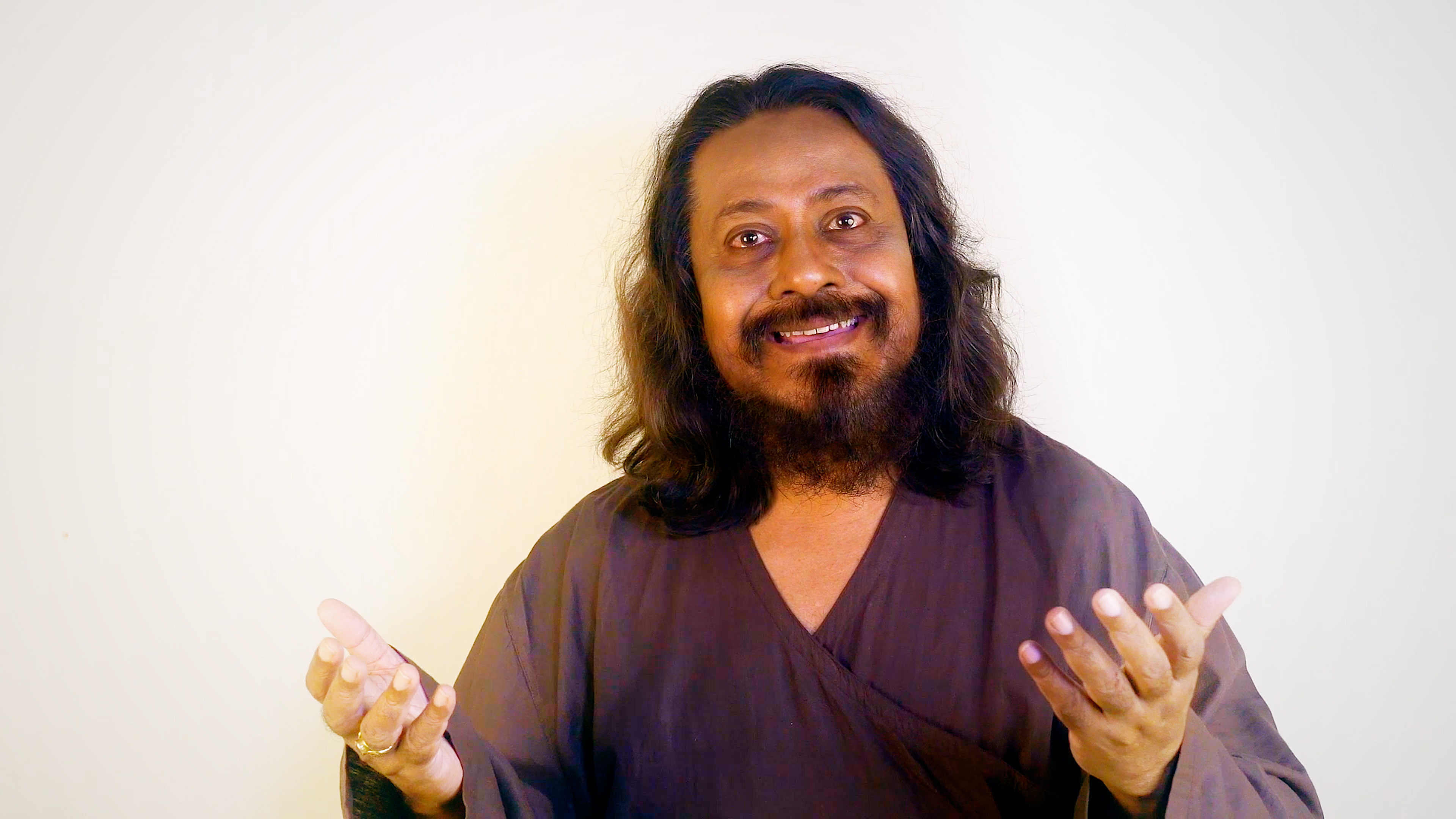
Soon after his return from England, Rabindranath Tagore and his brother Jyotirindranath, plunged into musical composition. Rabindranath, with his direct experience and influence of Western music and opera, immediately composed his opera Valmiki Pratibha (The genius of Valmiki) which quickly took its place in the repertoire. The composition, where melody and words had equal importance, had its roots in the special genius of Bengali music -- the keertans, and like a master, jeweller studded it with the gems of classical Hindustani raga-based music (ragasrayi) embellishing it with their own ideas and beautiful poetry. In addition, tunes of two English songs were borrowed for the drinking songs of the dacoit band and an Irish melody for the lament of the banadevis (wood nymphs).
Widely performed as a dance-theatre, dance-drama, to that effect drama, it remains as one of the few dramas of Tagore that has immediate and authentic appeal outside Bengal for its grandeur, vivacity, variety, vigour and wonderful gamut of styles and emotions missing from his later dramas.
To read the full report - Click here - http://srutimag.blogspot.com/2022/07/impressive-tributes-to-rabindranath.html


